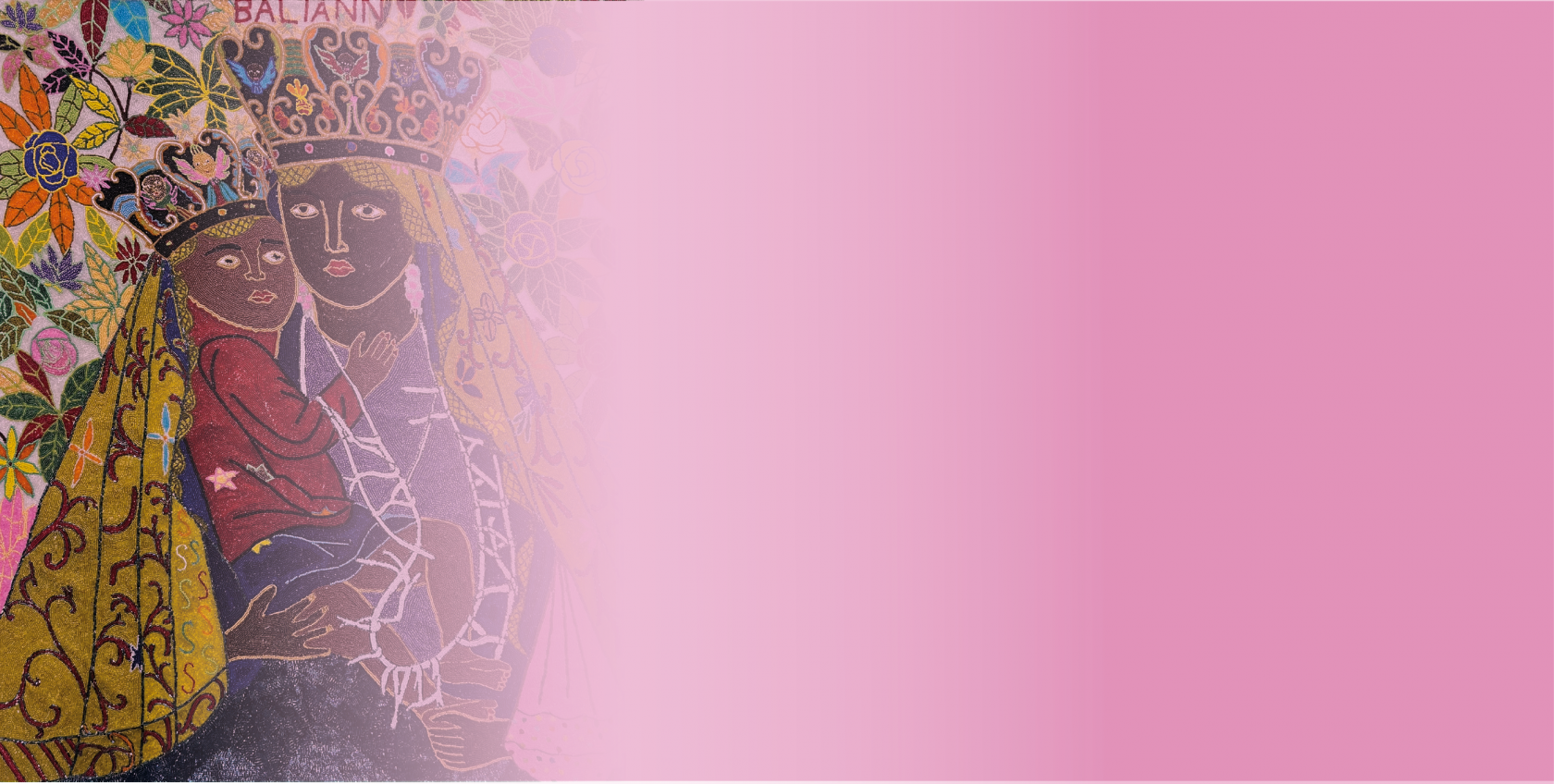
Aspects of Life and Culture in Haiti
Haiti's cultural landscape is a mosaic of African, Indigenous, and European influences. Everyday life features a deep sense of community, with extended families often living together and providing a solid support system for one another, fostering a strong sense of unity and inclusivity. The rhythm of daily life is accompanied by colorful and lively marketplaces where people buy and sell goods and street vendors peddle an array of traditional Haitian cuisine, such as griot (fried pork) and diri ak djon djon (rice with black mushrooms). Music is an integral part of the culture, with the moving beats of kompa (a modern méringue music genre) and rara (musical parading bands that mix carnival and religion) filling the streets and providing a soundtrack to daily activities. The streets are adorned with colorful murals and sculptures, showcasing the country's unique artistic expression. Religious ceremonies are vibrant communal affairs that reflect the deep spiritual connection of the Haitian people. A palpable sense of pride permeates everyday life as Haitians continue to celebrate their culture, preserve their traditions, and face the future with determination and strength.
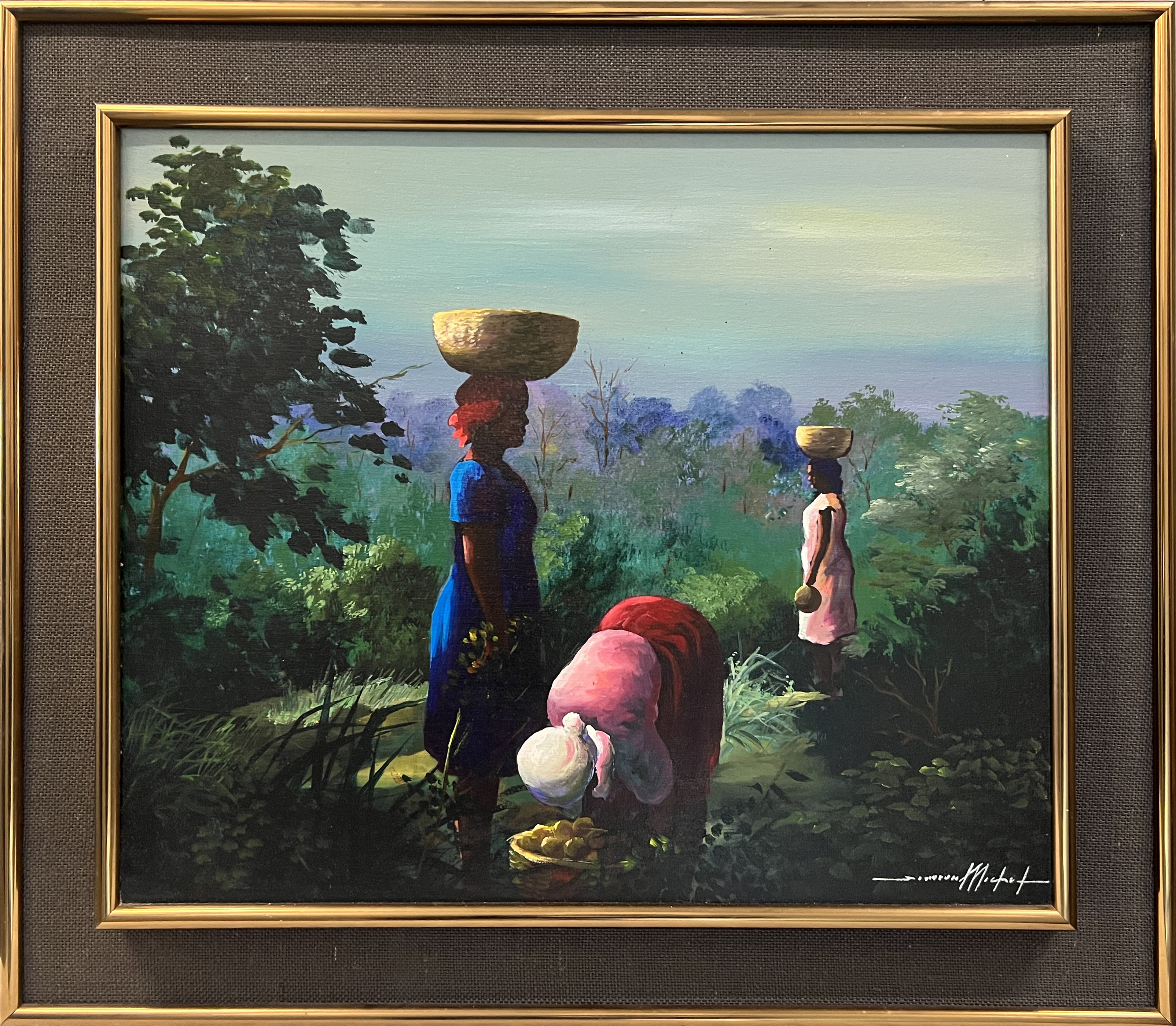 The Harvest (La Rekòt) The Harvest (La Rekòt)Simeon Michel Haiti Friends Collection |
This image captures the essence and rhythms of rural life, and the communal effort involved in harvesting crops. Through its composition and subject matter, the painting highlights the dignity of agricultural work and the deep connection between people and the land they cultivate. It serves as a reminder that agriculture plays a foundational role in the Haitian culture and economy.
 Fruit Picking (Kove) Fruit Picking (Kove)Pierre Joseph Valcin Haiti Friends Collection |
This image evokes a powerful visual commentary on the pivotal role of women in Haitian society, particularly within the context of family life and agricultural labor. The artist has employed a striking compositional technique to convey this message, rendering the female figures significantly larger than their male counterparts. The women dominate the canvas, drawing the viewer’s immediate attention and underscoring their importance. This tribute to Haitian women acknowledges their irreplaceable role in nurturing both the land and the people.
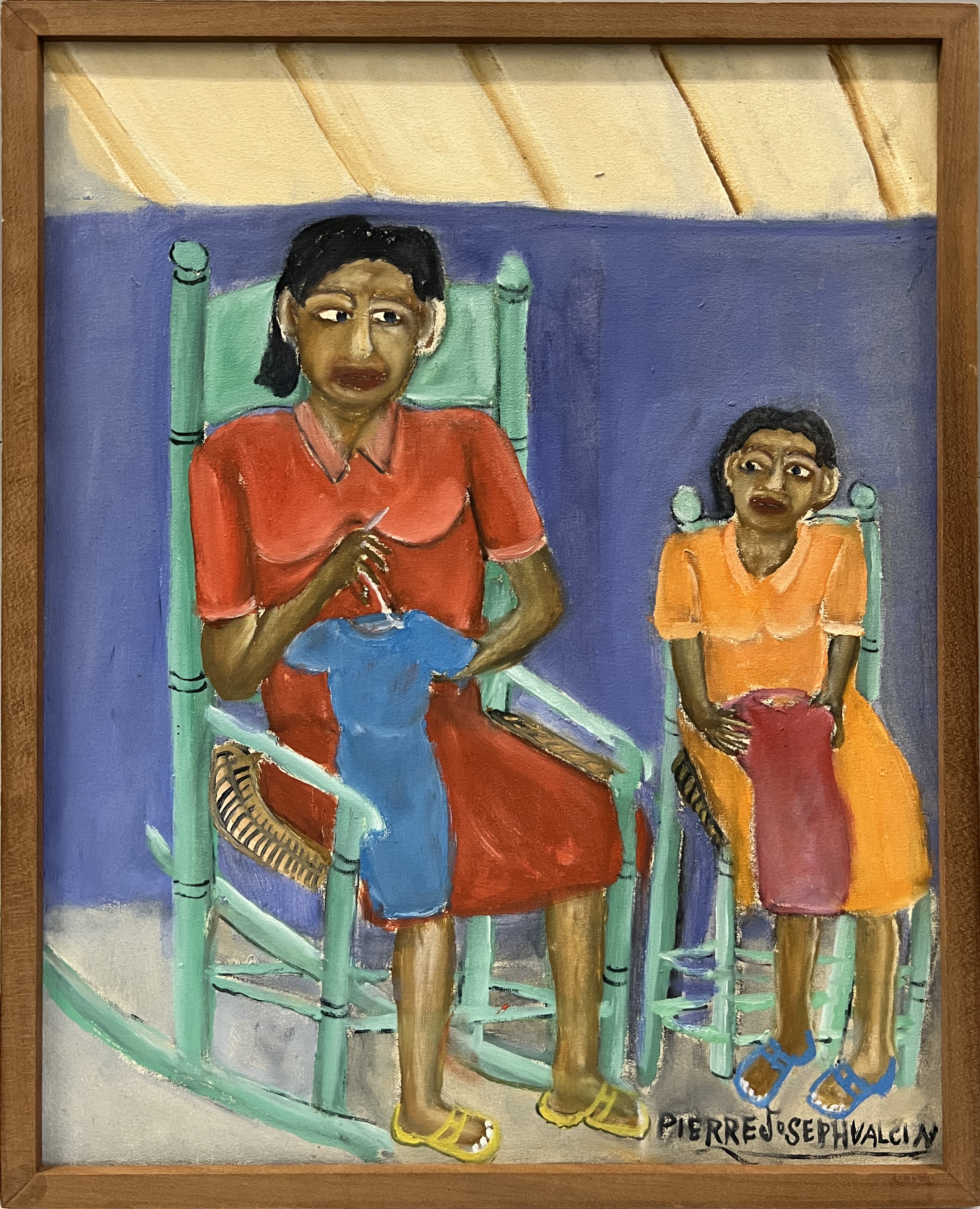 Mother and Child (Konbit) Mother and Child (Konbit)Pierre Joseph Valcin Haiti Friends Collection |
This Intimate glimpse into rural Haitian domestic life captures a moment of quiet connection between a mother and daughter in what appears to be their modest home. The painting celebrates the universal themes of the bond between mother and child, the quiet dignity of domestic labor, and the continuity of tradition.
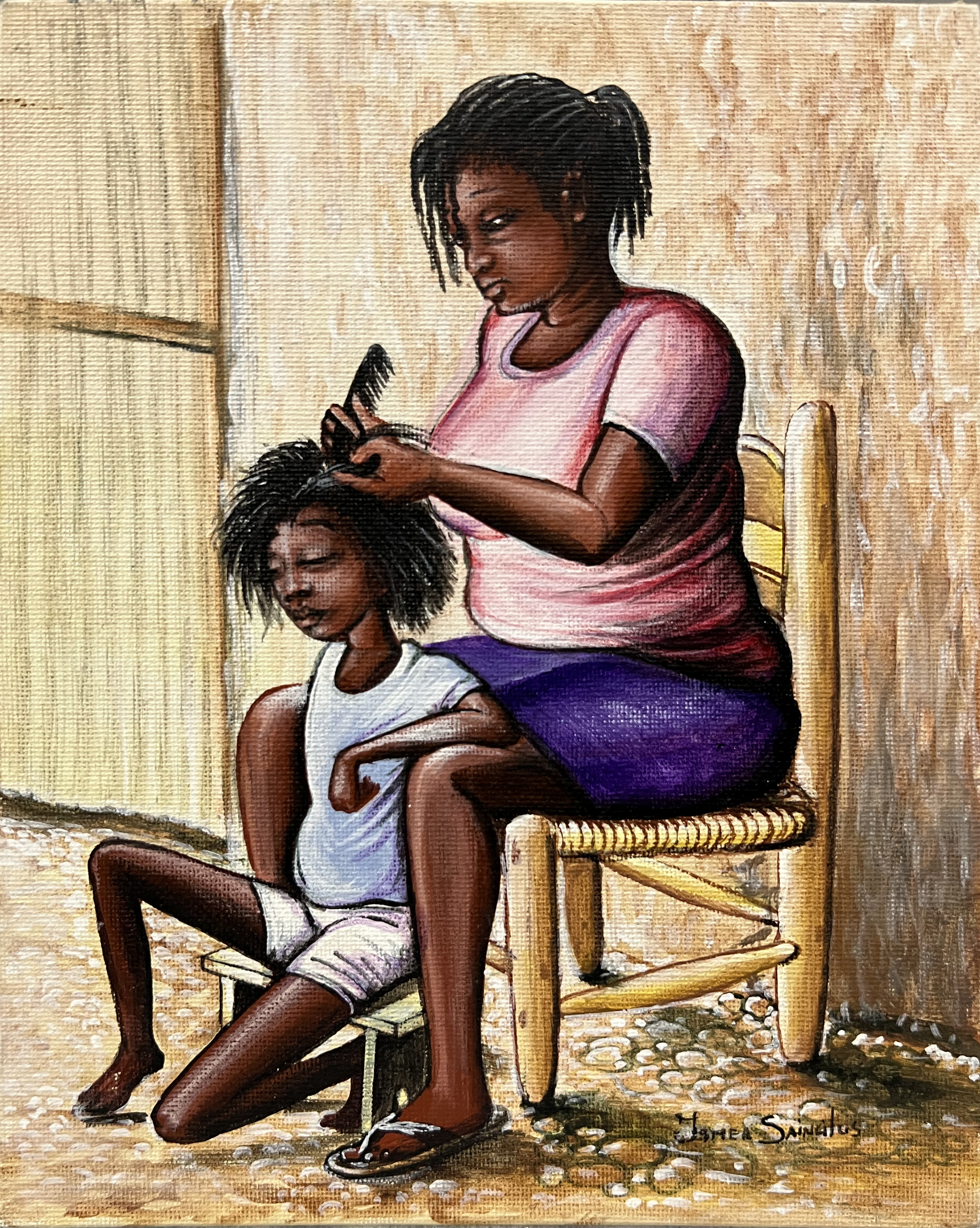 The Morning Braid (La Tresse Matinale) The Morning Braid (La Tresse Matinale)Ismer Saincilus Haiti Friends Collection |
A mother carefully braids her daughter’s hair, readying her for the day’s journey to school or the solemnity of church. This tender portrayal of a daily ritual is a snapshot of familial bonds and cultural traditions, woven together like the strands of hair in the mother’s skilled hands.
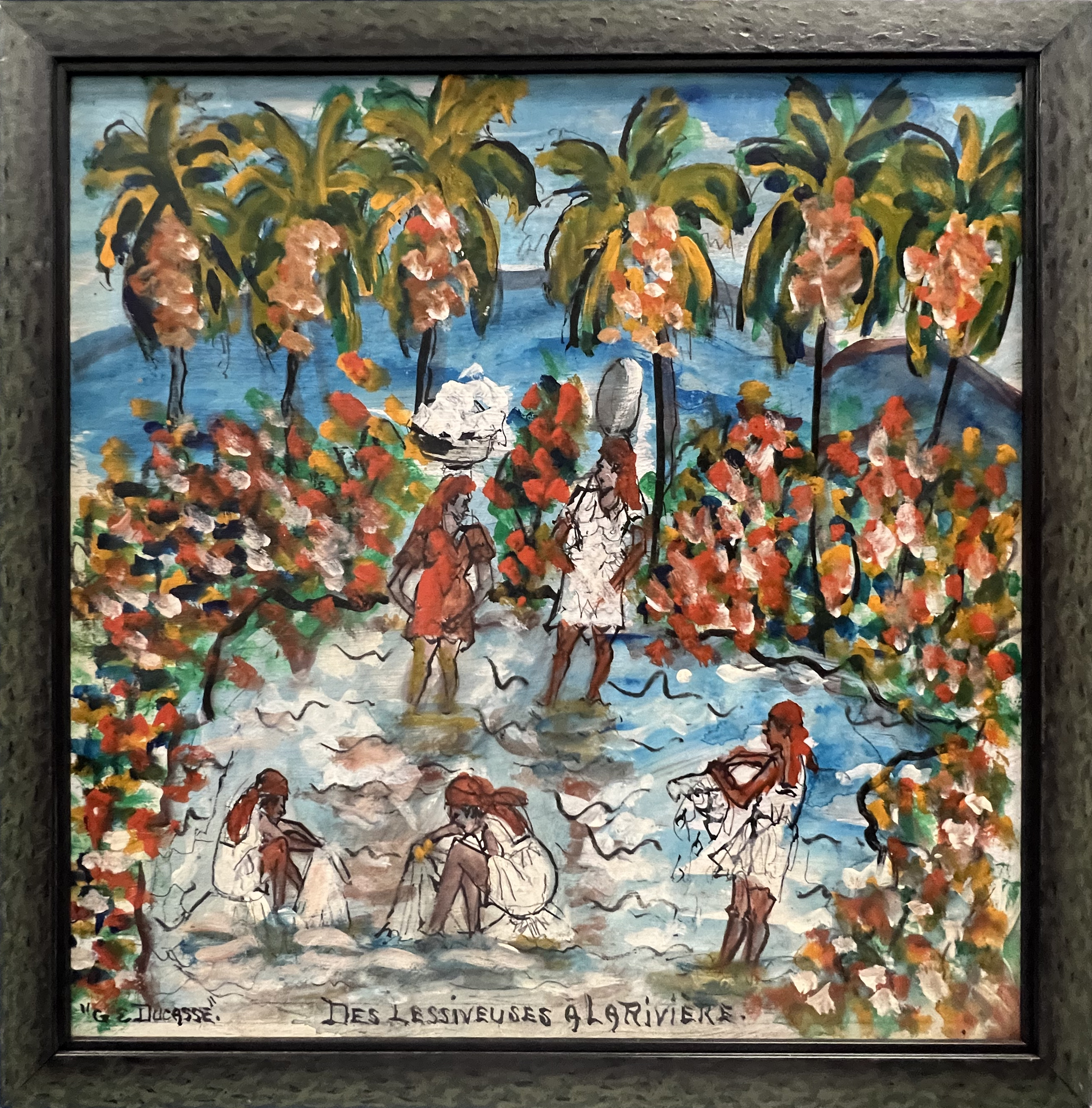 Laundry Day (Jou Lessiv la) Laundry Day (Jou Lessiv la)Gervais-Emmanuel Ducasse (1903-1988) Haiti Friends Collection |
A laundry day by the river in Haiti is a picturesque and communal activity, reflecting the simplicity and camaraderie of rural life. The sound of water splashing, and rhythmic scrubbing fills the air as women work together, chatting and laughing. Children play nearby, sometimes helping with smaller tasks. The river is a lively social hub, where news is exchanged, stories are told, and bonds are strengthened.
Artibonite School (L'école de L'Artibonite)
The late Ismael Saincilus was an influential Haitian artist whose influence can be seen in many of the works in this exhibit. Several of his sons continue the artistic tradition that he established. Ismail, his sons, and other friends created L'école de L'Artibonite (Artibonite School), a renowned art school in Haiti known for its emphasis on traditional artistic techniques and the cultivation of young talent. Artists trained at this school are producing some of the most well-respected works portraying Haitian life and culture.
 Working Together (Konbit) Working Together (Konbit)Serge Francois Haiti Friends Collection |
A konbit is a traditional Haitian communal work gathering in a rural village. The scene brims with energy and purpose, showcasing the community's collaborative spirit and embodying the essence of konbit—a system of mutual aid deeply rooted in Haitian culture.
 Preparing Cassava in the Village (Preparasyon Kasav) Preparing Cassava in the Village (Preparasyon Kasav)Elphabe Dieudonne Haiti Friends Collection |
The preparation of cassava in a rural Haitian setting is carried out in several stages, with some people peeling and washing the cassava roots, while others transport the roots in baskets. Overall, the painting emphasizes community involvement and the use of traditional methods in a rural setting.
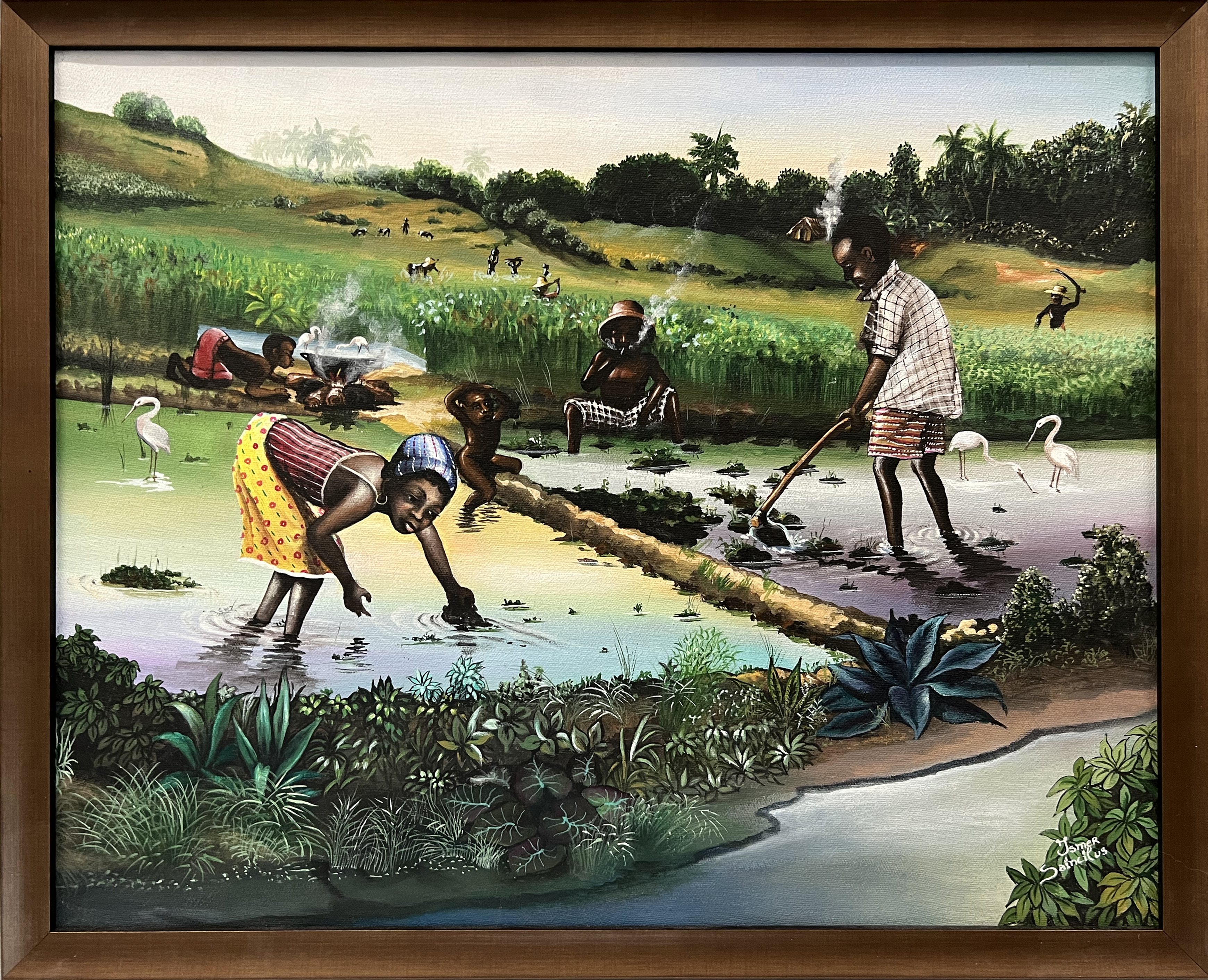 Artibonite Workers Planting Rice (Travayè Latibonit kap plante diri) Artibonite Workers Planting Rice (Travayè Latibonit kap plante diri)Ismer Saincilus Haiti Friends Collection |
The laborers in this painting are meticulously planting rice in the Artibonite Valley, a region important for its agricultural activities and renowned for producing rice.
 The Woodcutters (Travayè kap fè planch) The Woodcutters (Travayè kap fè planch)Louis Gumcy Haiti Friends Collection |
In rural areas of Haiti, traditional craftsmanship persists in the art of house construction. Far from modern sawmills, skilled workers collaborate in the labor-intensive task of transforming a massive tree trunk into usable boards. Armed with hand saws, these artisans carefully slice through the wood, their movements synchronized in a display of teamwork and precision.
 The School Recess (Rekreyasyon lekòl la) The School Recess (Rekreyasyon lekòl la)Louis Gumcy Haiti Friends Collection |
A school recess in the countryside of Haiti is a lively and heartwarming scene. As the bell rings, children rush out of their classrooms, eager to enjoy their break. The schoolyard comes alive with the sounds of laughter and playful chatter. Teachers stand at the periphery, watchful but allowing the children this precious time of free play. The air is filled with a mix of Creole and French, a linguistic dance reflective of Haiti's rich cultural heritage.
 Splendor of the Haitian Countryside Splendor of the Haitian CountrysideCharles Larrimer Saincilus Haiti Friends Collection |
An ode to Haiti’s pastoral charm, this painting captures the essence of nature’s grandeur. It portrays the splendor of one of the serene landscapes of Haiti. Central to this visual symphony is the Poul dlo, a bird known to many as the Moorhen. This avian symbol embodies the harmonious balance of the region’s flora and fauna within the lush countryside.
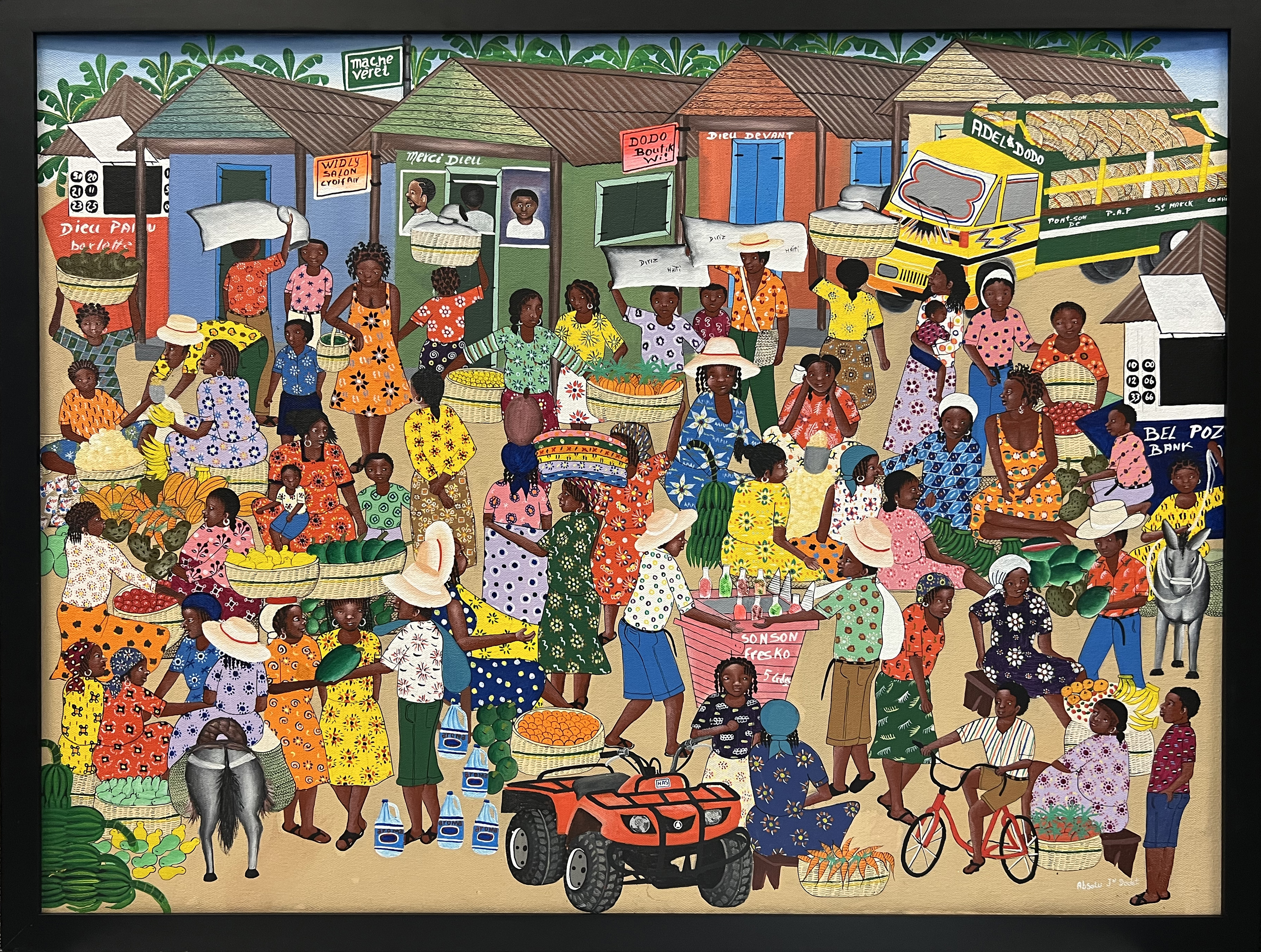 Market Scene in the City (Mache la vil) Market Scene in the City (Mache la vil)Absolu Jean Dodet Haiti Friends Collection |
In the heart of a bustling Haitian city, the market is a dense, frenetic hive of activity. Narrow alleys are crammed with makeshift stalls and tables, creating a maze-like environment. The air is thick with the mingling scents of exhaust fumes, spices, and grilled street food. Vendors, mostly women known as (Madan Sara,) compete for space and attention. Their stalls overflow with a mix of local and imported goods.
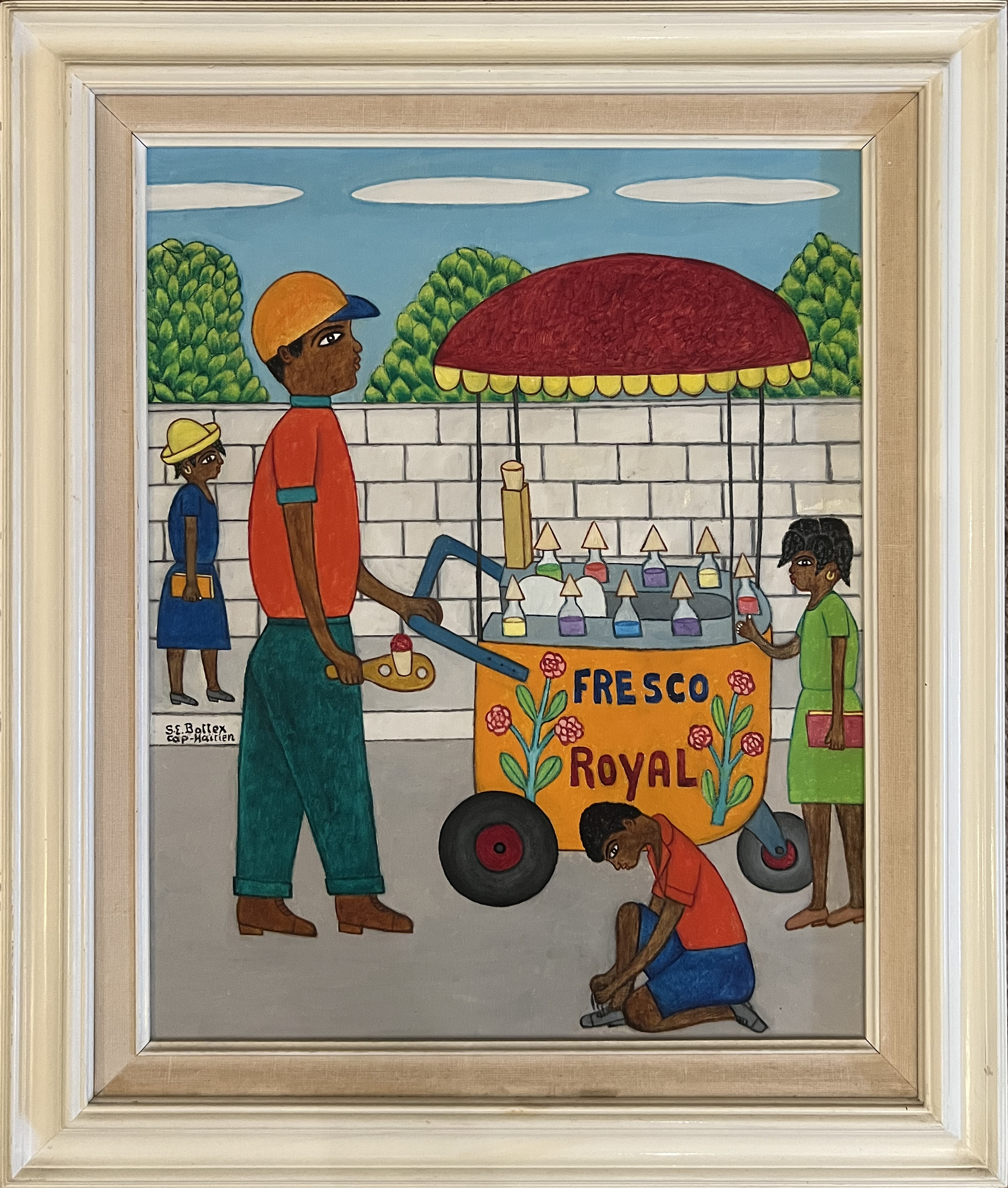 Shaved Ice Merchant (Machan Fresco) Shaved Ice Merchant (Machan Fresco)Seymour E. Bottex (1922-2016) Haiti Friends Collection |
This Haitian street-life scene centers on fresco (shaved ice) vendors. The cart itself is a visual feast adorned with intricate floral patterns that burst with color. This artwork highlights the resourcefulness of local entrepreneurs and the simple pleasures that form the fabric of daily life in Haiti, inviting viewers to appreciate the beauty in these everyday moments.
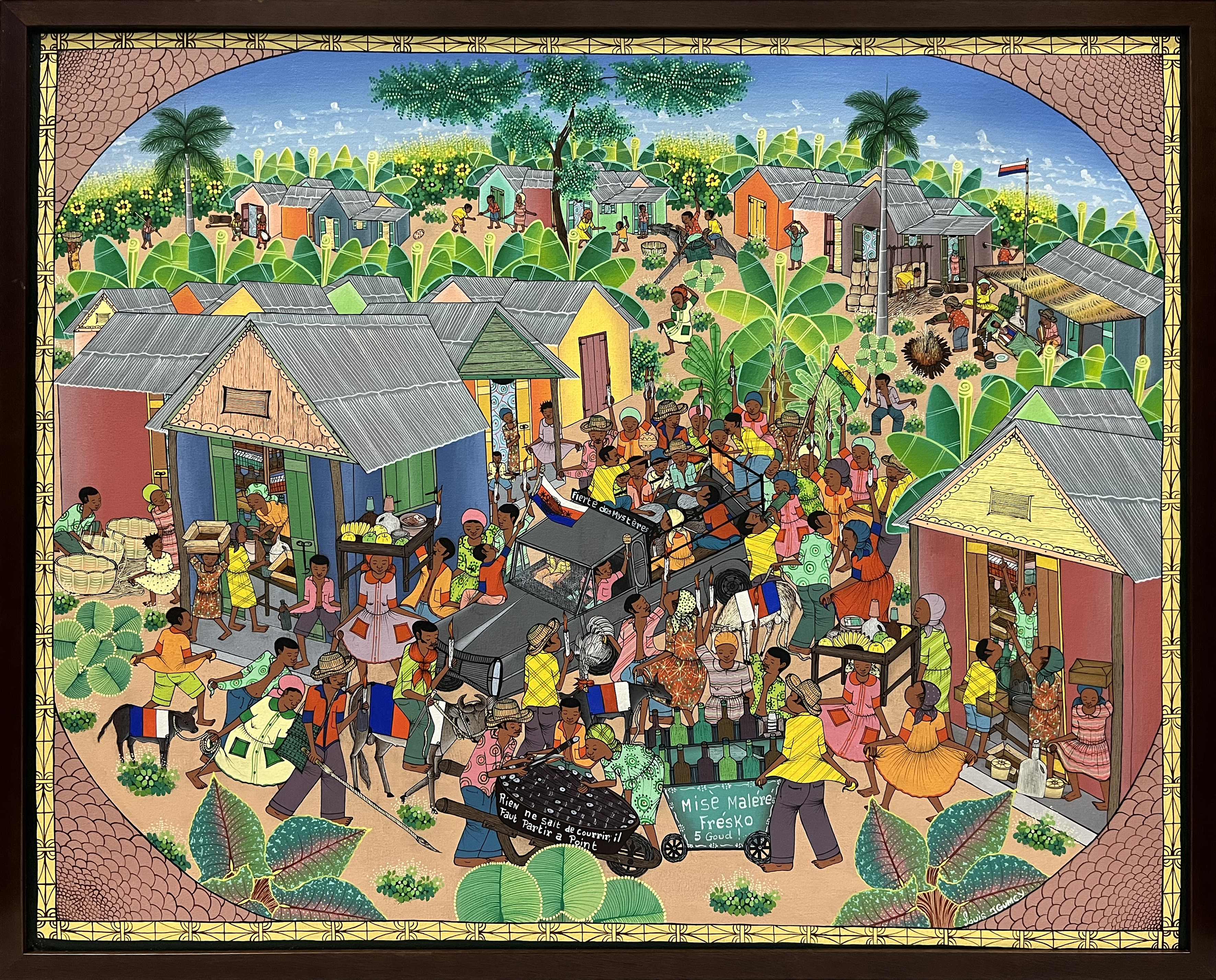 Market Scene (Sèn mache) Market Scene (Sèn mache)Louis Gumcy Haiti Friends Collection |
Haitian markets are vibrant bustling displays of daily life and community spirit. Vendors sell a variety of goods from colorful stalls and women with baskets balanced on their heads walk through the crowd offering fresh fruits, vegetables, spices, and handmade crafts. The market is not just a place for commerce but a social hub where people come together to share news, stories, and a sense of community.
 Croix des Bossales Market in Port-au-Prince (Marche Croix des Bosal port-au-prince bord de mer) Croix des Bossales Market in Port-au-Prince (Marche Croix des Bosal port-au-prince bord de mer)F. Lamille Haiti Friends Collection |
The Croix des Bossales market teems with life, depicting a diverse array of figures engaged in the daily bustle of commerce. Originally known as "Place des Bossales," this site was once one of the largest slave markets during Haiti's colonial period. The term "bossale" referred to newly arrived Africans who had not yet been forcibly acculturated or 'creolized'. Today's lively market stands in stark contrast to its origins. The transformation of this space from a site of oppression to a center of community and commerce reflects the broader narrative of Haiti's struggle for independence and its ongoing cultural vitality.
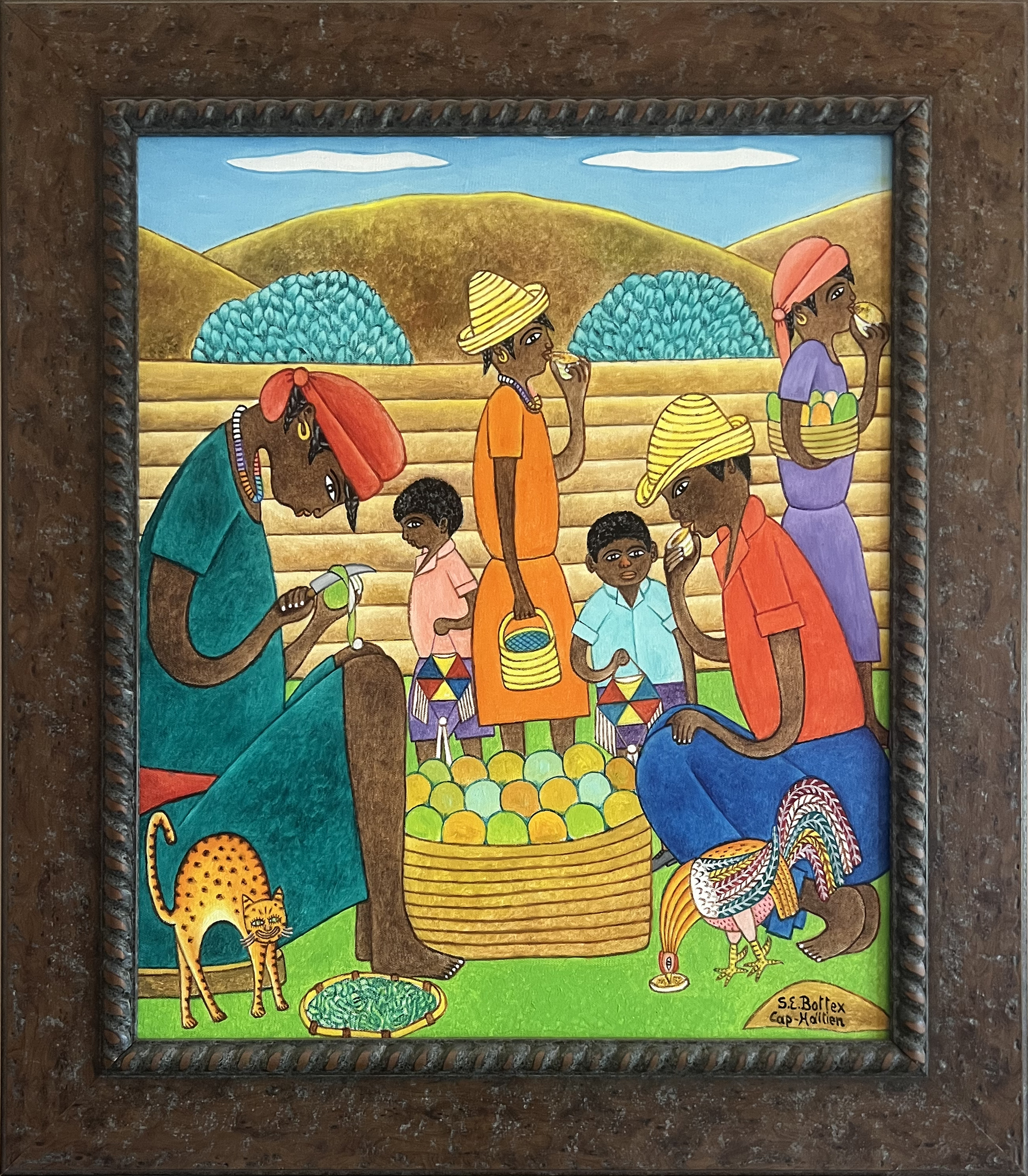 The Orange Merchant (Machan Zorang) The Orange Merchant (Machan Zorang)Seymour E. Bottex (1922-2016) Haiti Friends Collection |
A candid moment in Haiti's countryside is captured here, showcasing the interaction between a man who has paused on his way to a cockfight and an orange merchant (machan zorang). This vignette offers viewers a glimpse into daily life and commerce in rural Haiti, highlighting the importance of small-scale vendors and the cultural significance of activities like cockfighting in local communities.
Recycled Steel Drums
One of the most unique genres of Haitian art uses recycled steel drums. Metal drums, once used for transporting oil or other products, are purchased by artists near the port in the capital city of Port-au-Prince. They are brought by hand cart or on top of a taxi to workshops in the neighboring town of Croix-des-Bouquets. When driving through the streets, one hears the rhythmic sounds of metalworking from the homes of various artists.
In Haiti, One Man's Trash is Another's Art Supplies (youtube.com)
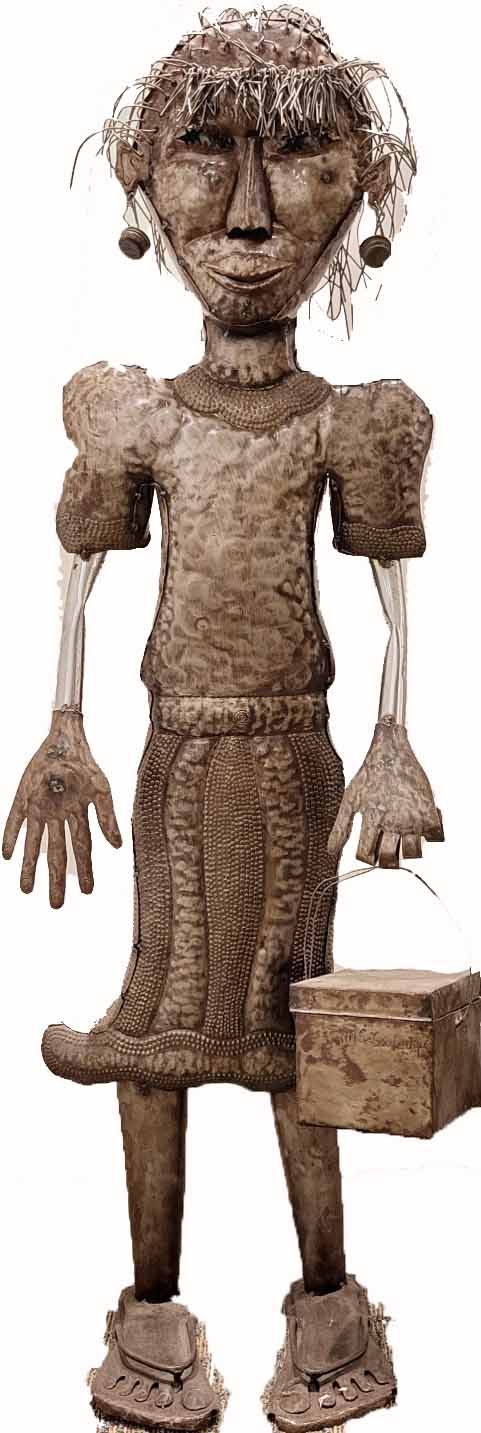 Portrait of Lucy Rawson Portrait of Lucy Rawson Jonas Soulou Que Croix-des-Bouquets Metal Haiti Friends Collection |
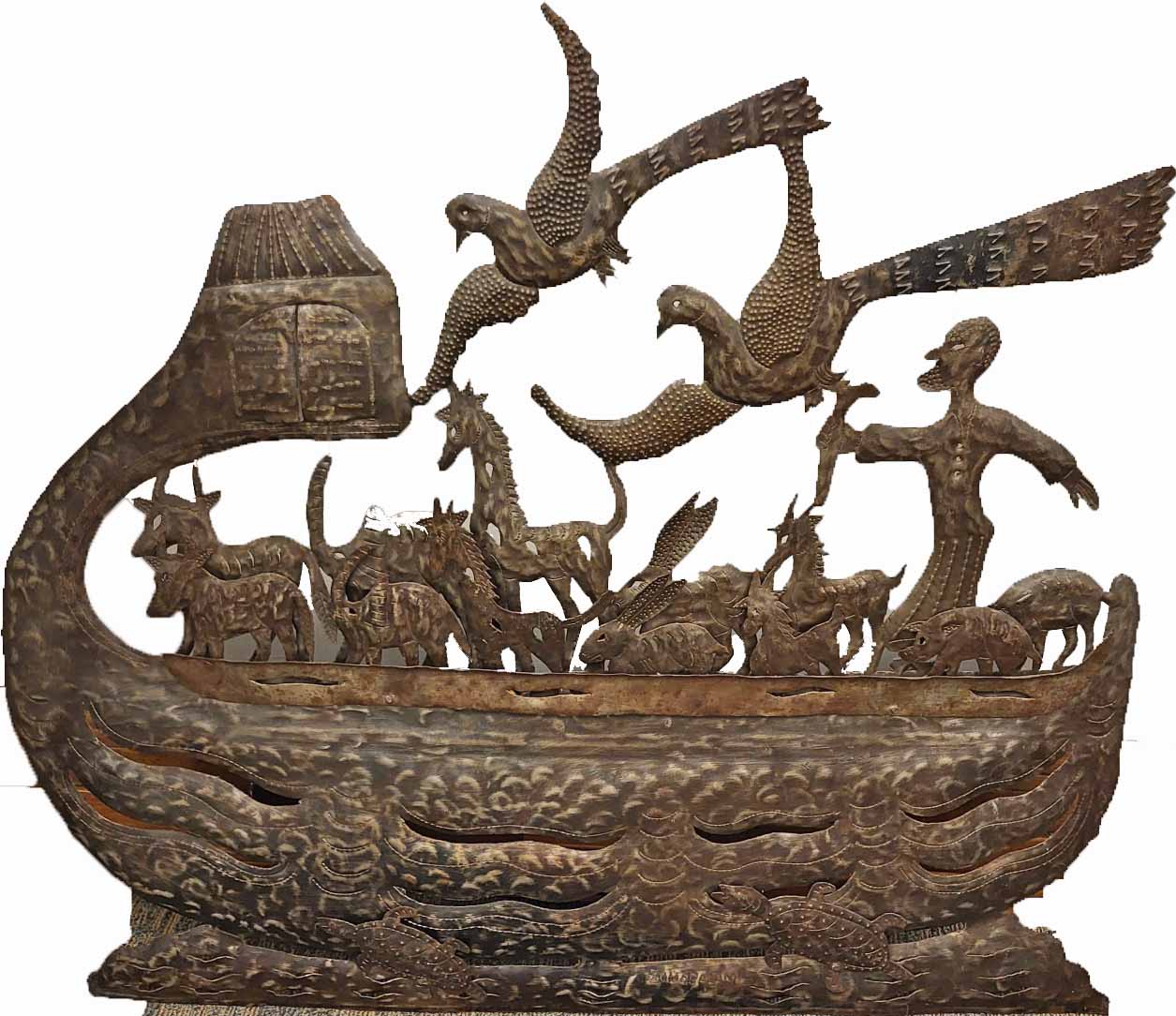 Noah’s Ark Noah’s ArkJulia Balan Croix-des-Bouquets Metal Haiti Friends Collection |
 La Sirène La Sirène Serge Jolimeau Croix-des-Bouquets Metal Haiti Friends Collection |
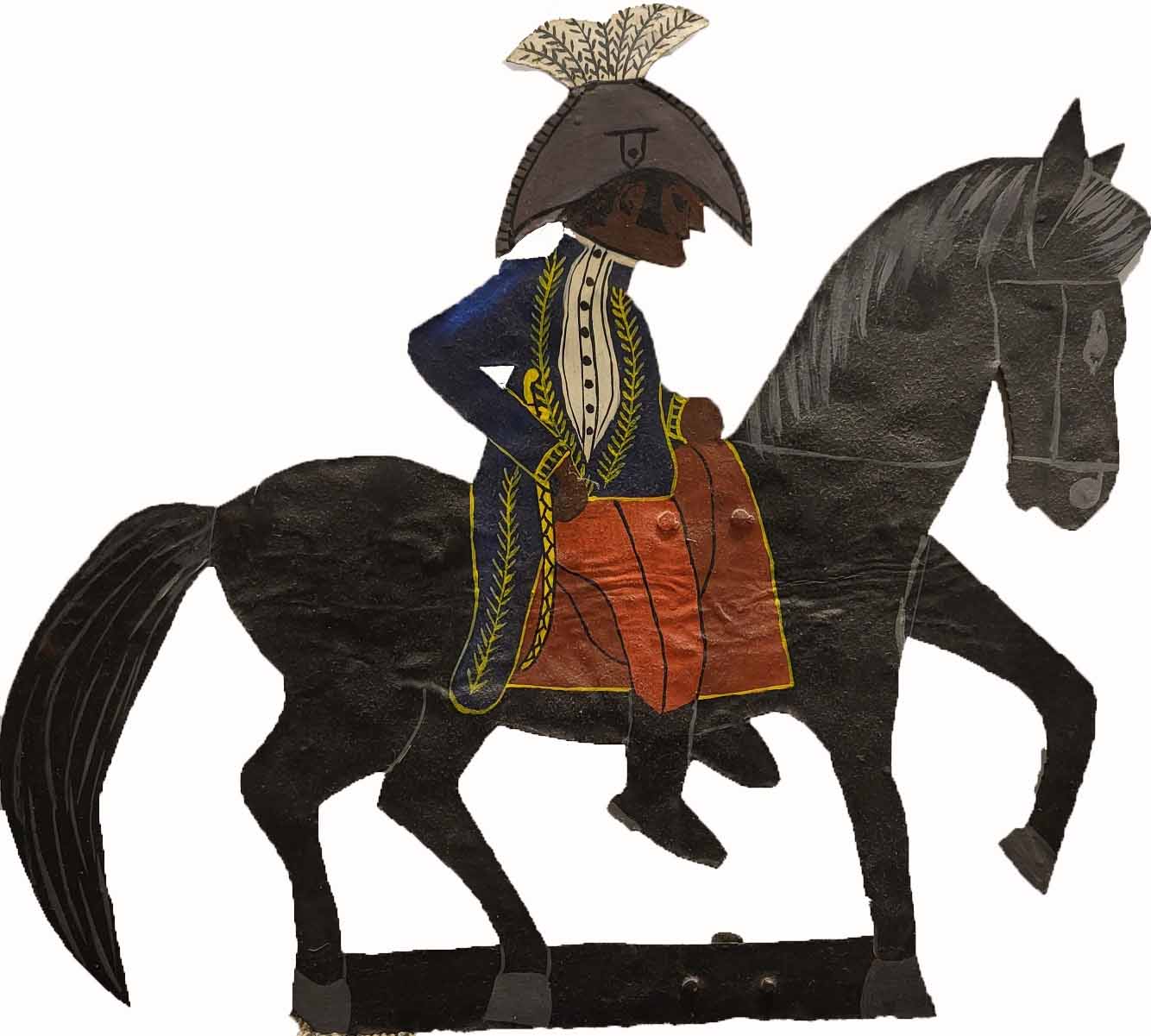 Artist unknown Artist unknownCroix-des-Bouquets Metal Haiti Friends Collection |
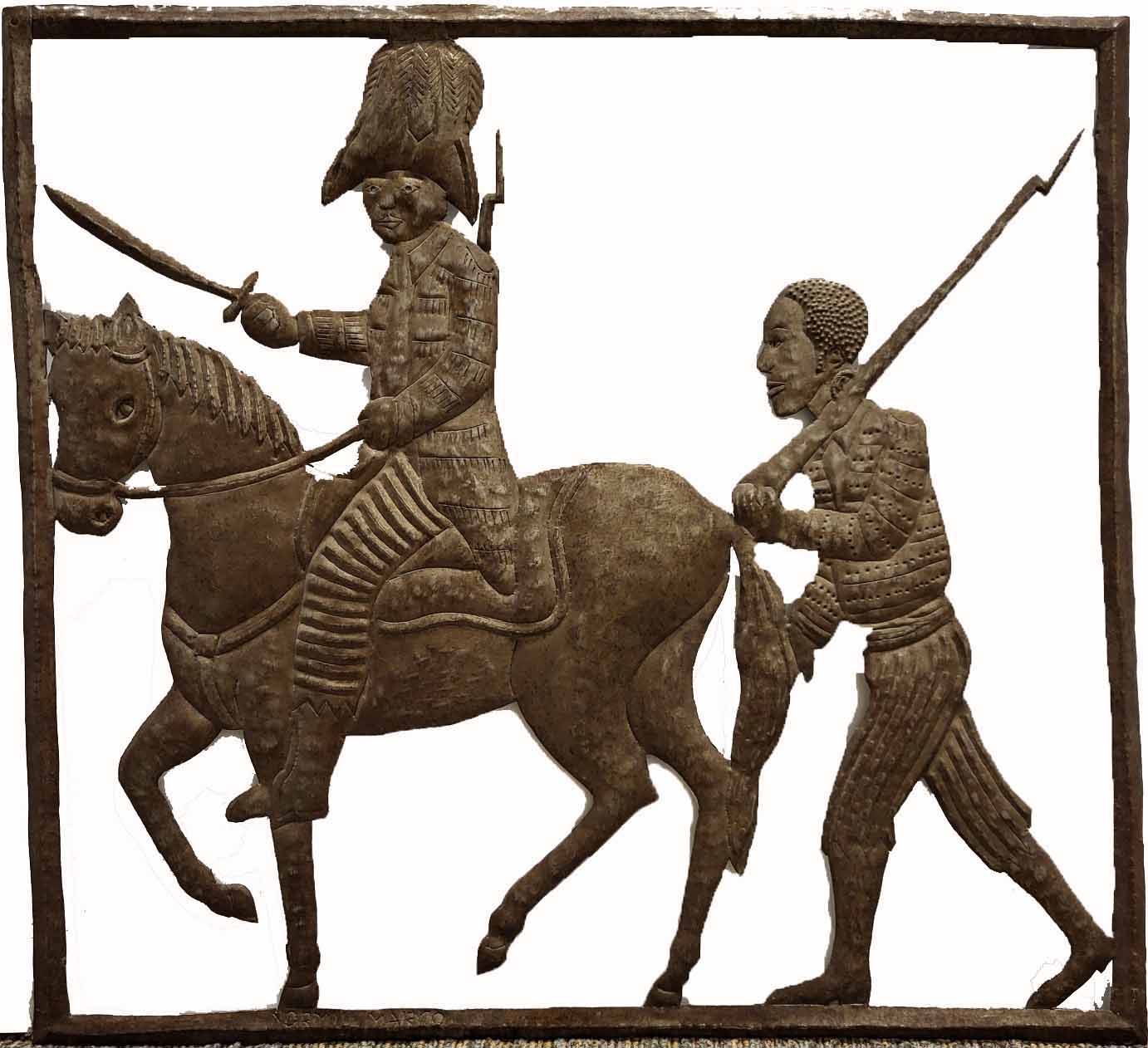 Artist unknown Artist unknownCroix-des-Bouquets Metal Haiti Friends Collection |
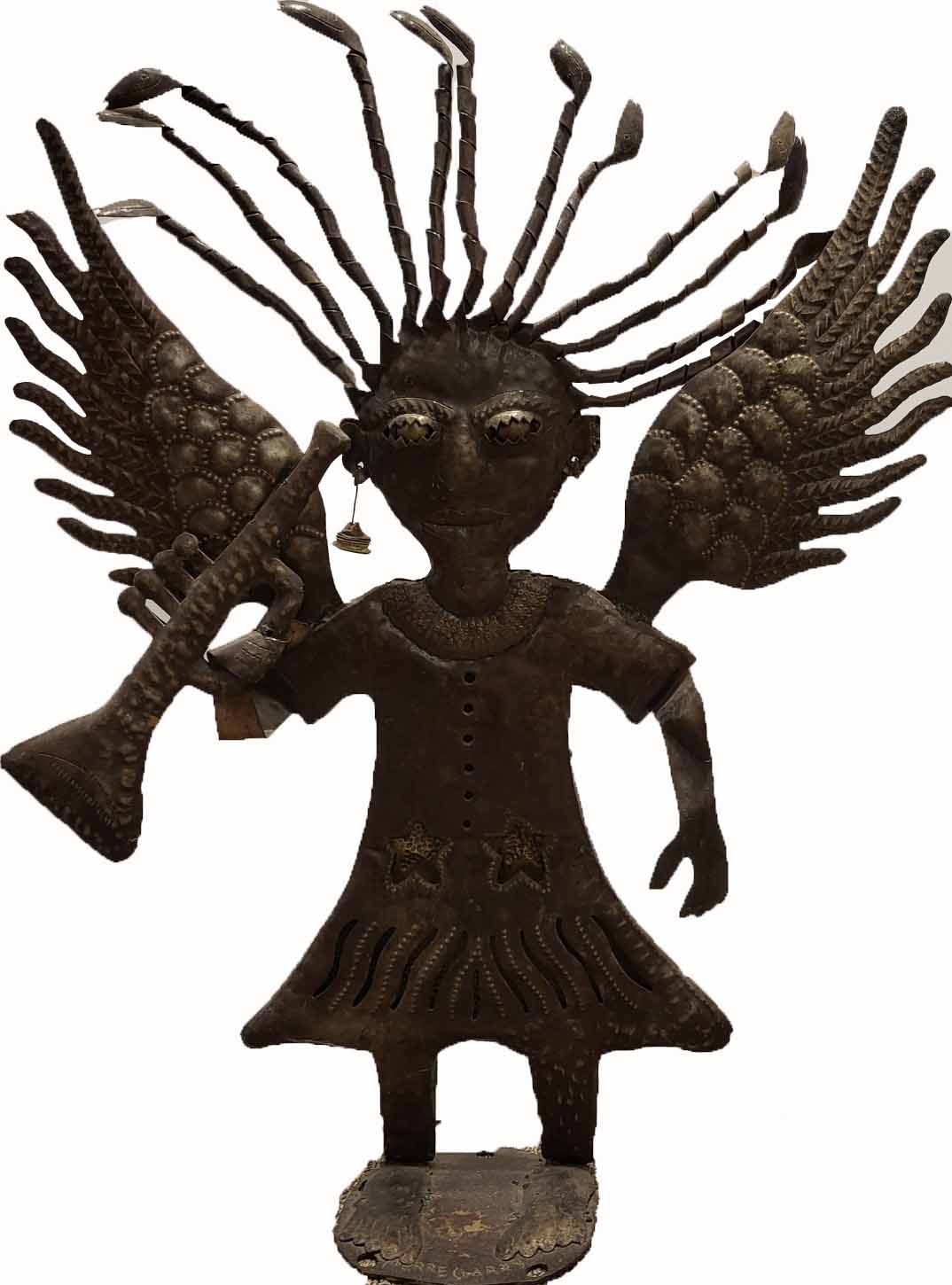 Angel with Horn Angel with HornPierre Garry Croix-des-Bouquets Metal Haiti Friends Collection |
Wood Sculptures
Wood is a precious commodity in Haiti. Lumber is costly because so much of the country’s forests have disappeared. The most common way for Haitians to cook food is using charcoal made from small tree bits. Wood is highly valued and artists have been creating sculptures out of this medium for decades.
 Family FamilyT.W. Midiel Wood Haiti Friends Collection |
 Fish Boat People Fish Boat PeopleNelio Jeantu Wood Haiti Friends Collection |
Cockfighting
Cockfighting (called gaguere) is an important part of sport and social life in Haiti, particularly in the countryside and in rural areas. Although it is becoming more controversial in some circles, cockfighting is a deeply ingrained part of life. The matches are well-attended spectator attractions, and many people bet on the results. The importance of cockfighting is reflected in the many representations of roosters and cockfighting in Haitian art.
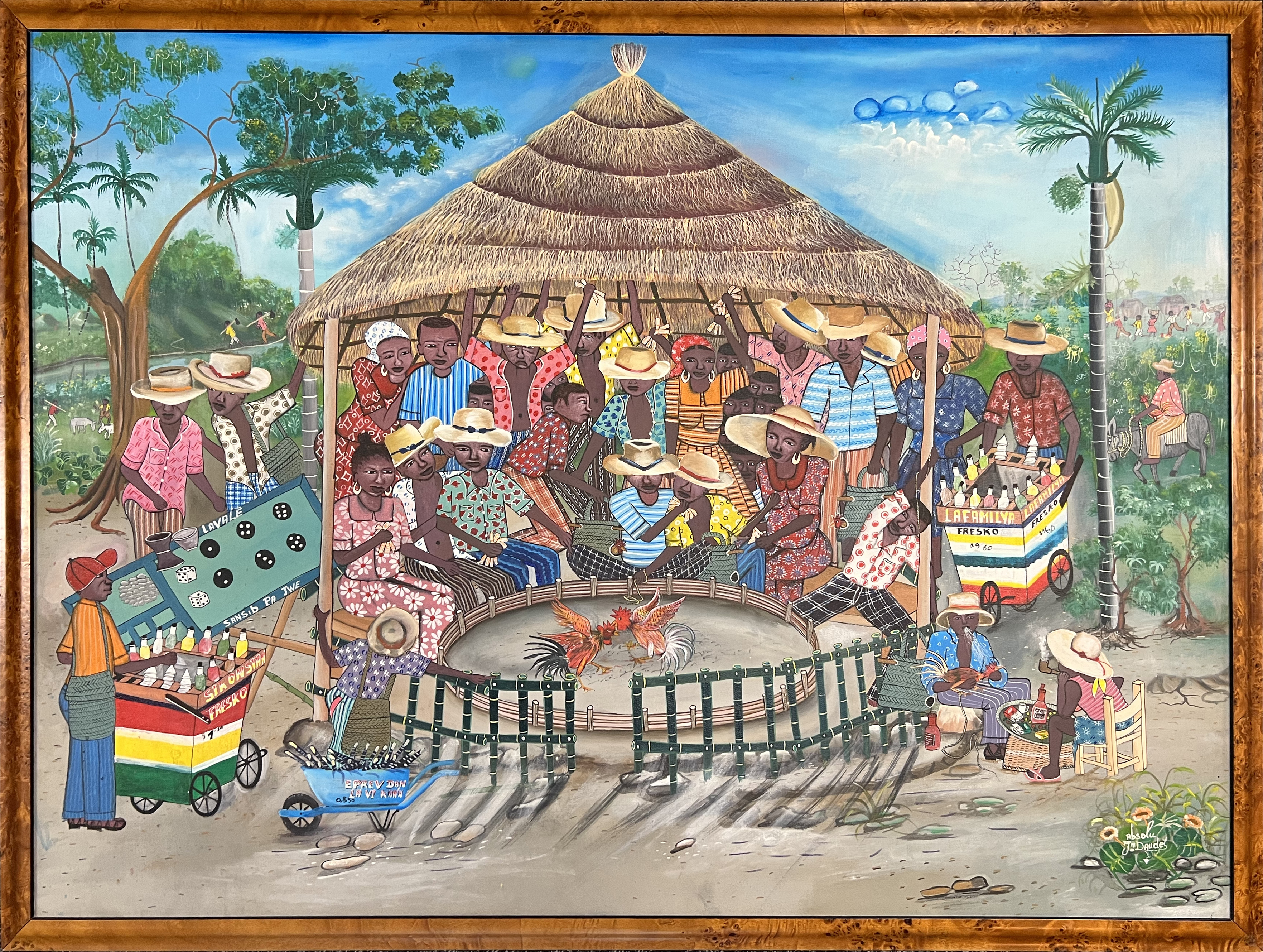 Cockfight (Gagère) Scene Cockfight (Gagère) SceneAbsolu Jean Daudet Haiti Friends Collection |
Portrayed here is the exciting scene of a cockfight. Spectators and onlookers are placing bets while the intense cockfight unfolds. Outside, merchants use the opportunity to sell their goods amidst the excitement.
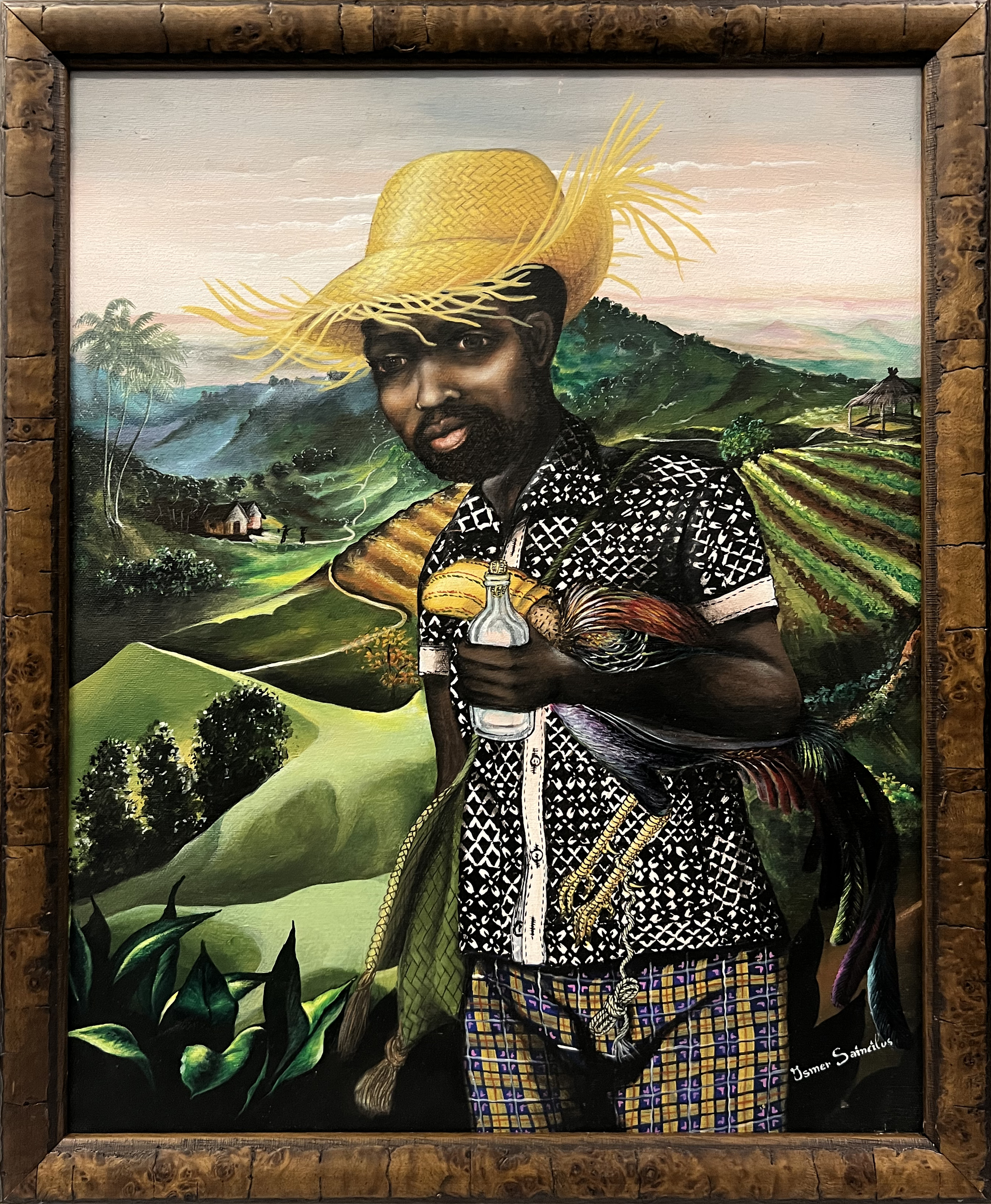 Journey to the Arean (Depa pou Gagè a) Journey to the Arean (Depa pou Gagè a)Ismer Saincilus Haiti Friends Collection |
This man is laden with anticipation as he traverses the path to the cockfighting arena. His countenance is etched with concern, a testament to the high stakes riding on the impending rooster fight. The Gado, guardians and trainers of the combatant bird, often invoke the spirits, seeking their favor to fortify the rooster’s might. The poignant scene is more than a mere depiction; it is a narrative of hope and anxiety, of man and beast, all converging upon the battleground of the arena.
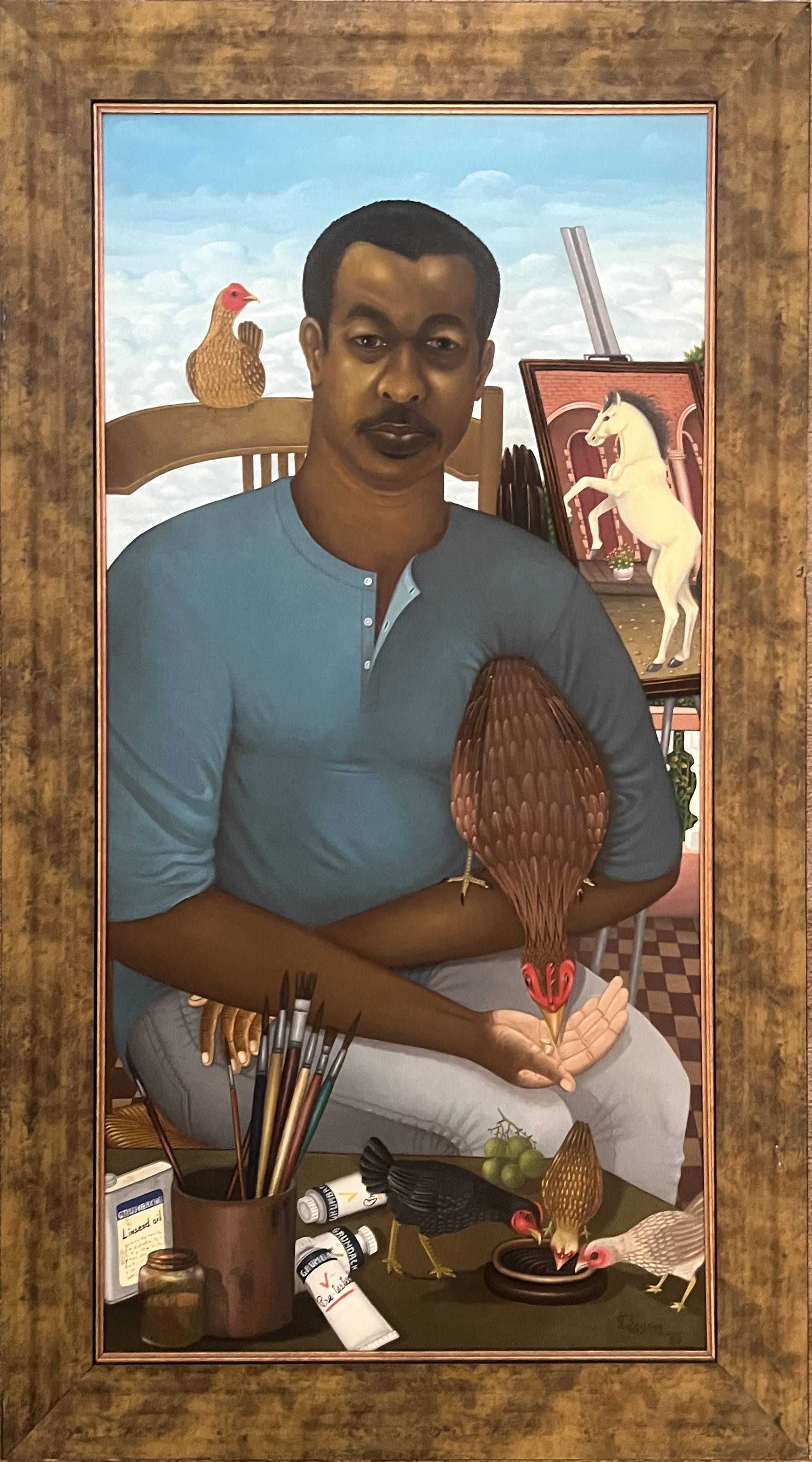 The Rooster Keeper (Gado) The Rooster Keeper (Gado)Fritzner Lamour Haiti Friends Collection |
This self-portrait of Fritzner Lamour, who paints chickens as people, shows him gently tending to a rooster presumably used for cockfighting. The setting appears to be in his studio, evidenced by the paintbrushes, paint tubes, and the easel with a horse painting.
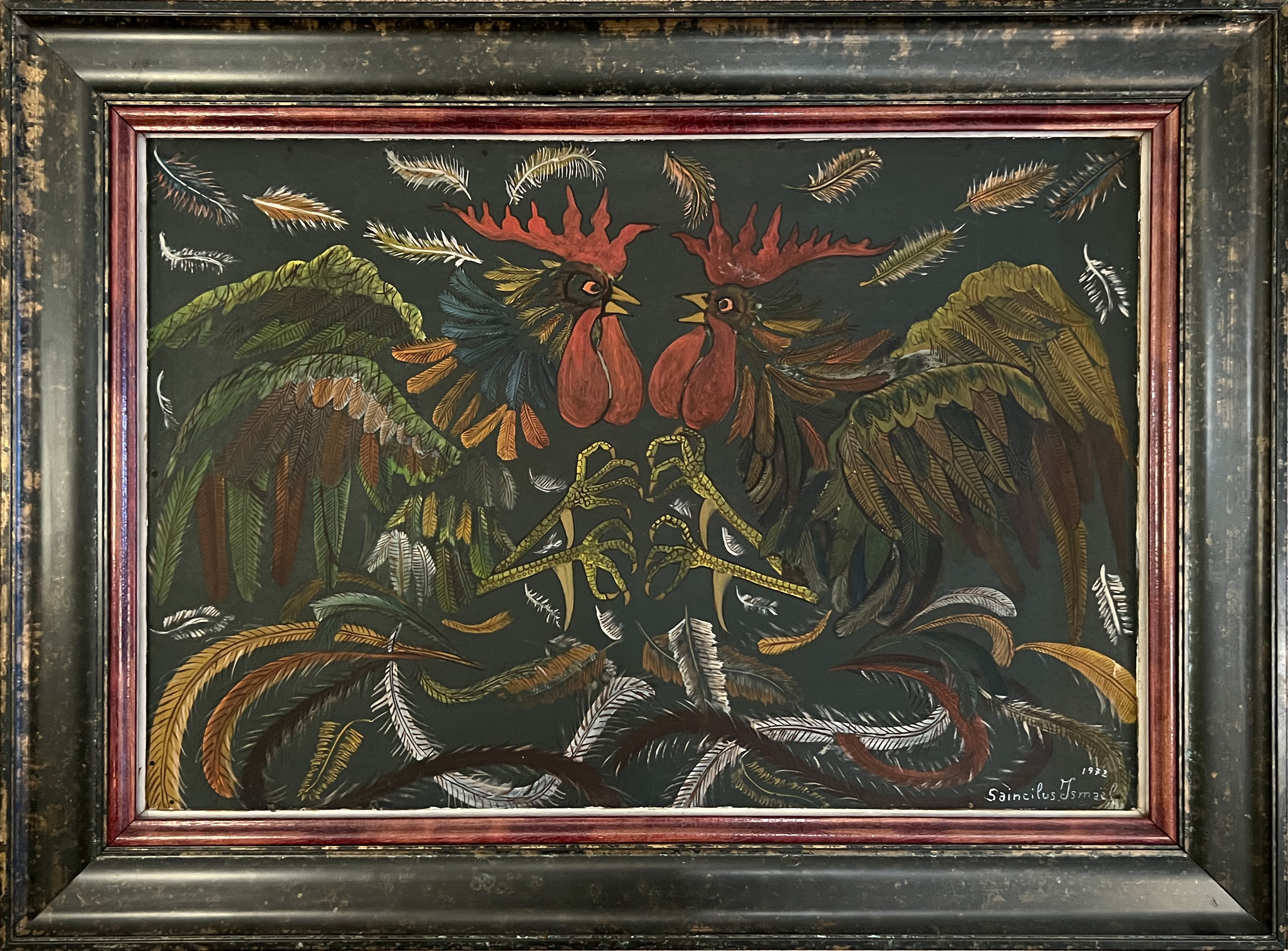 Cockfight (Batay kòk) Cockfight (Batay kòk)Ismael Saincilus (1940-2000) Haiti Friends Collection |
The cockfight takes place in an arena known as a “Gagère,” however, the painting depicts no spectators at this event. Instead, the artist intends for the artwork’s viewers to assume the audience’s role, placing them directly into the scene as virtual attendees of this intense avian combat.
 Tire Kont Tire KontCarol Jean-Jacques (1943-1990) Haiti Friends Collection |
Portrayed here is the rich cultural tradition of tire kont (communal storytelling and riddle-sharing) in a Haitian courtyard. Despite historical challenges and limited resources, communities find joy, wisdom, and unity through traditions like tire kont.
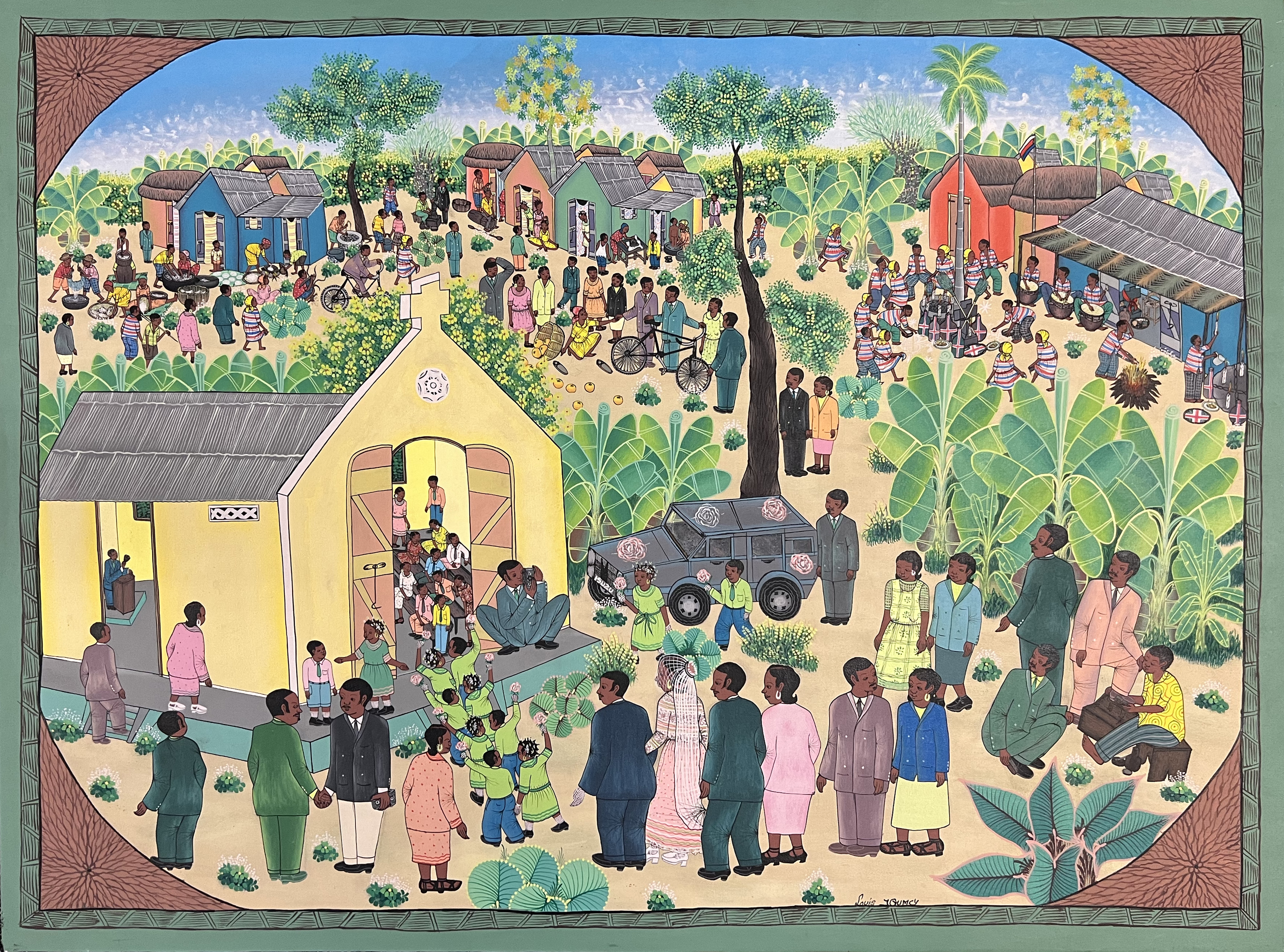 The Wedding (Maryaj la) The Wedding (Maryaj la)Louis Gumcy Haiti Friends Collection |
At weddings in the Haitian countryside, the entire community gathers for the ceremony, with everyone dressed in their best attire. Highlighting the solidarity of the community, every person is ready to contribute whatever it takes to make the day special for the newlyweds. For example, the person with the most beautiful car lends it to the newlyweds as a sign of respect.
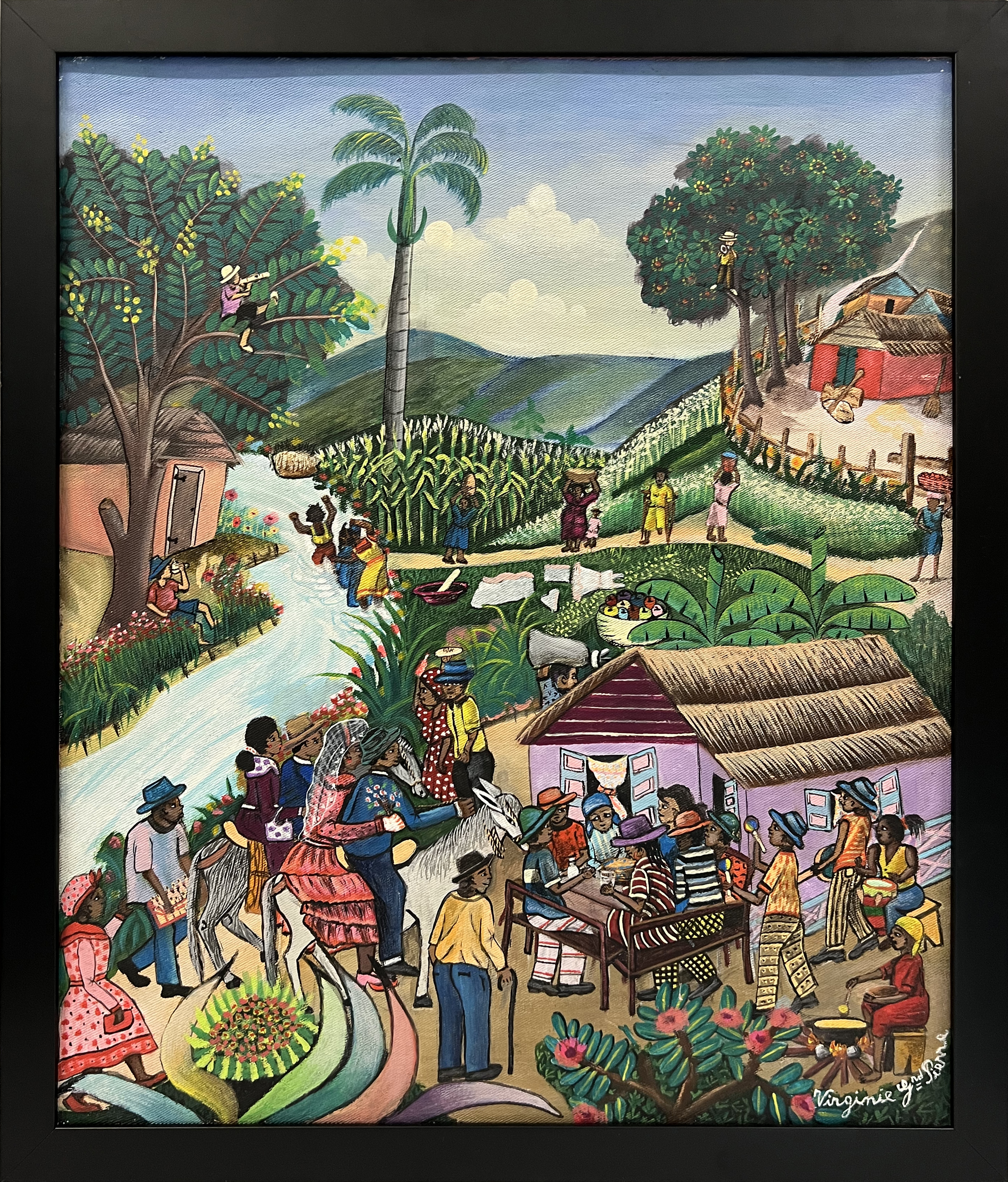 The Bride's Return to the Village (Retou lamarye nan vilaj li) The Bride's Return to the Village (Retou lamarye nan vilaj li)Virginie Grand-Pierre Haiti Friends Collection |
The return of a newlywed couple to their village after their wedding celebration is a joyous moment. Beside the bride, still resplendent in her wedding attire, her husband sits atop a majestic white horse. The white horse, associated with purity and nobility, enhances the ceremonial atmosphere of the scene. Family members, friends, and neighbors all welcome home the newlyweds and extend the celebration of their marriage.
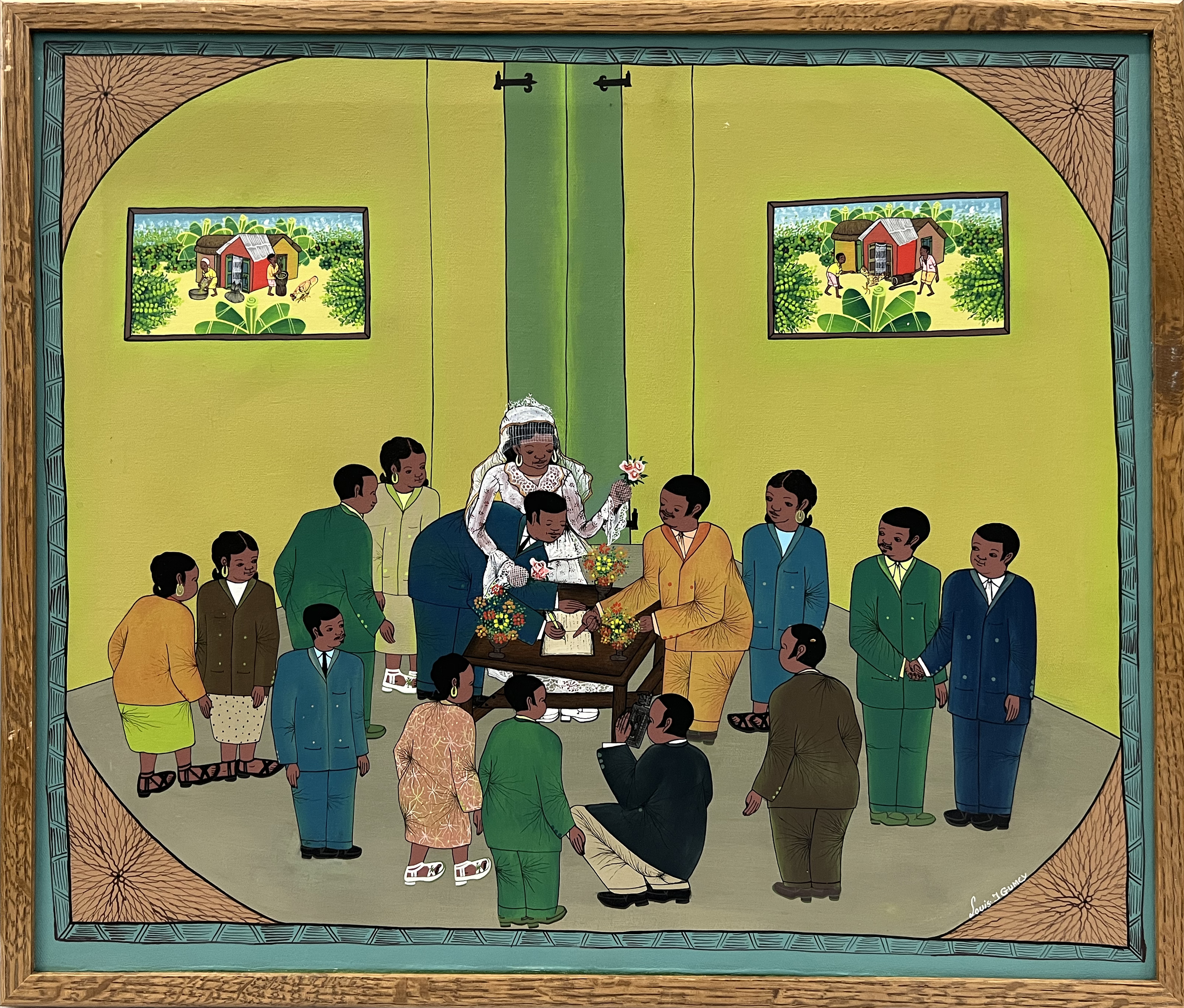 The Wedding 2 (Maryaj la 2) The Wedding 2 (Maryaj la 2)Louis Gumcy Haiti Friends Collection |
The bride and groom register their wedding.
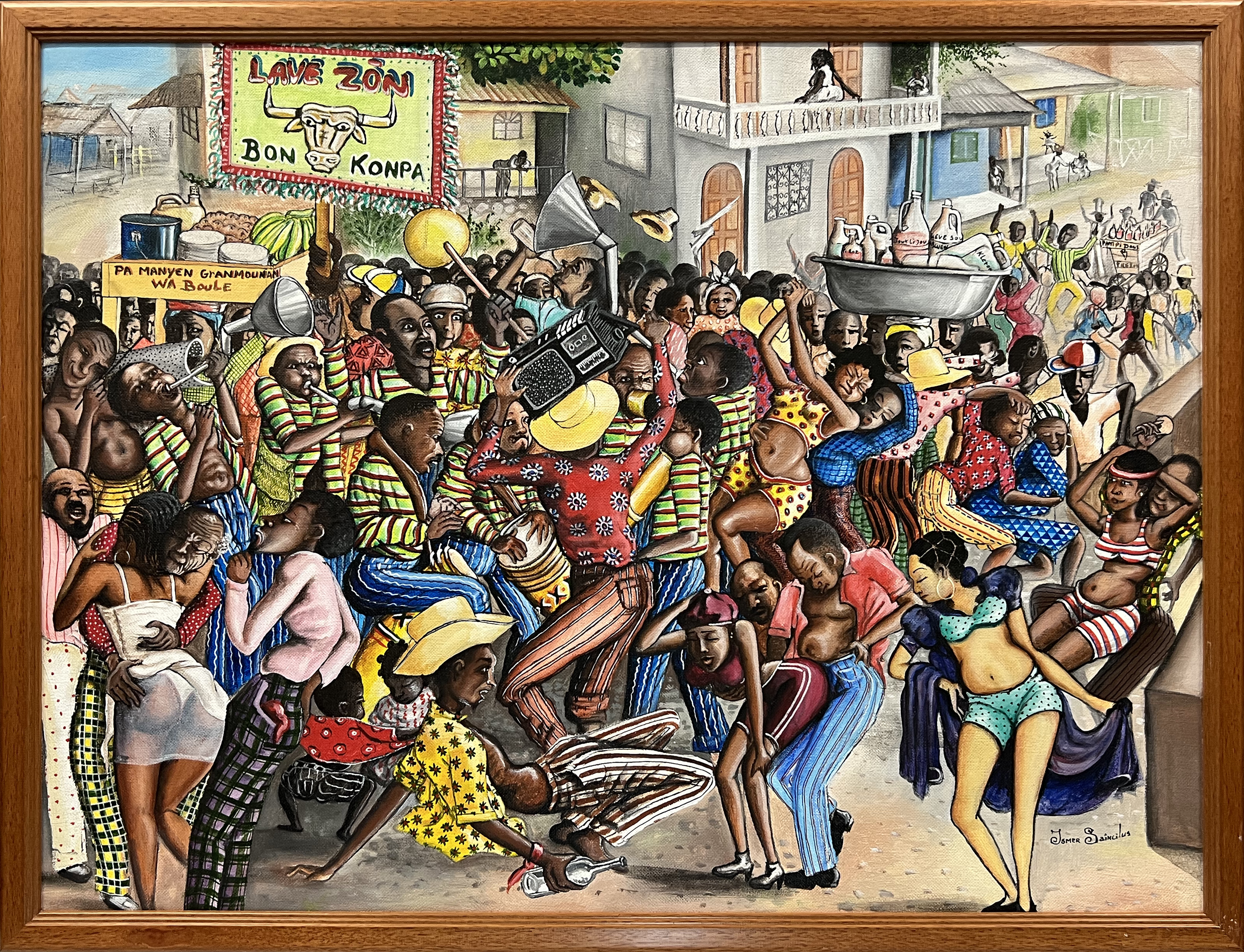 Rara RaraIsmer Saincilus Haiti Friends Collection |
Rara is an annual street festival for followers of Vodou. This ensemble from Fort Saint Benoit is playing rara festival music. The band, known as “Lave zon,” is famed for its ability to uplift any community with its music, ensuring that wherever it performs, joy and merriment abound.
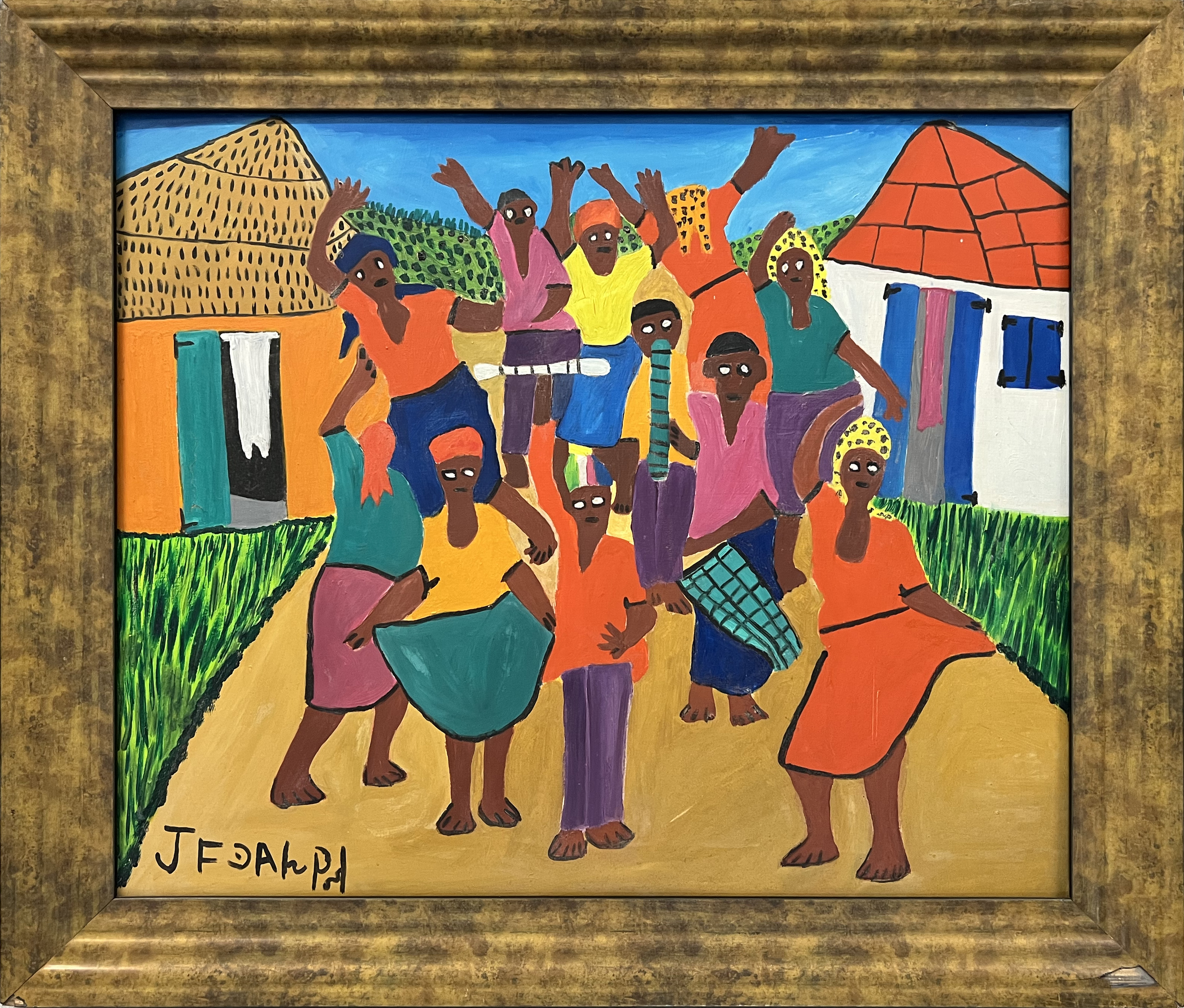 Rara in a Lakou (Rara na Lakou a) Rara in a Lakou (Rara na Lakou a) Artist unknown Haiti Friends Collection |
The essence of a Haitian rara celebration within a traditional lakou (courtyard) is captured here. The scene is alive with a swirling mass of figures, their bodies rendered in bold, dynamic strokes that convey the energy of the rara procession. This painting captures not just the visual spectacle of rara, but also its spirit – the sense of community, the preservation of tradition, and the joyous celebration of Haitian culture and resilience.
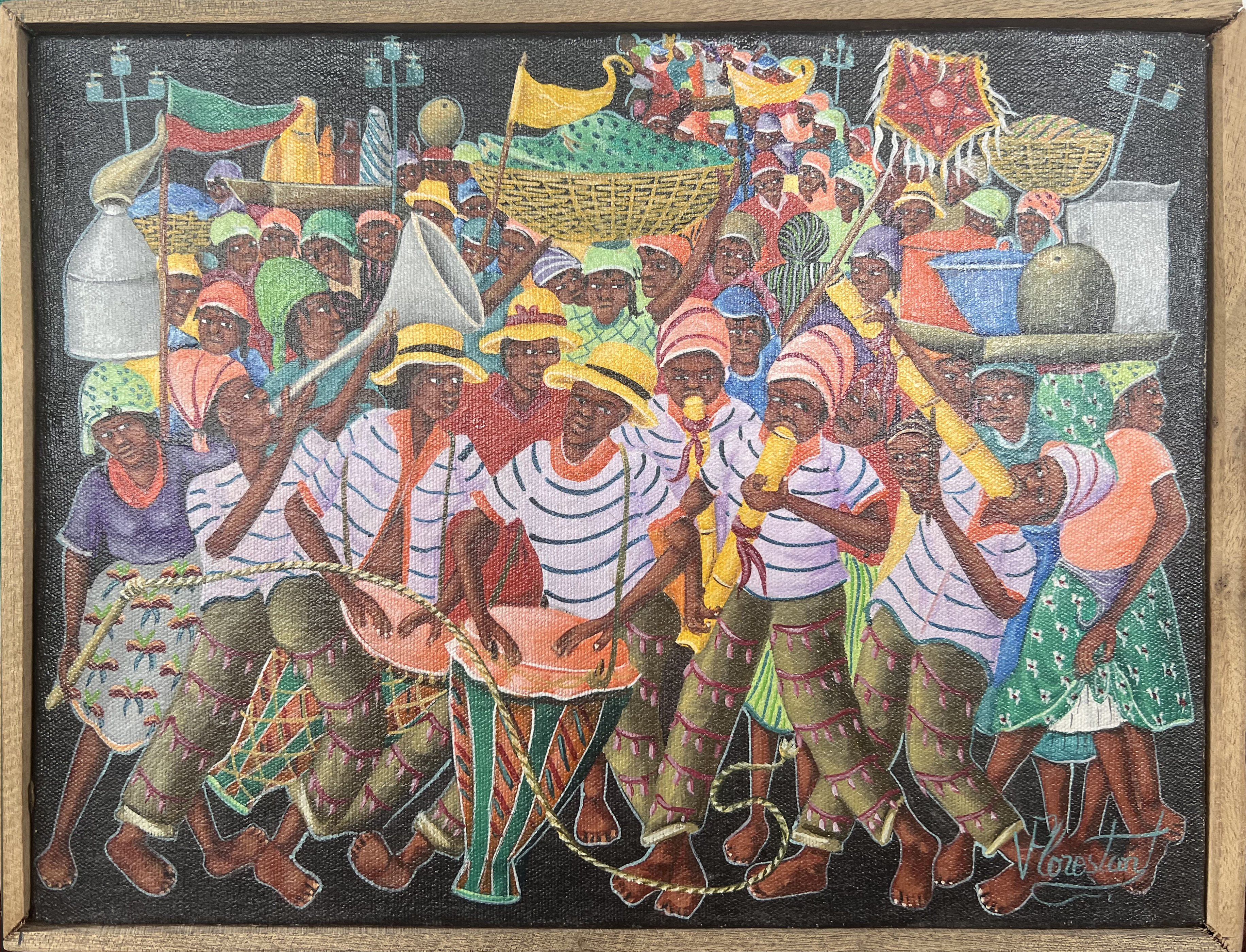 Rara Léogâne Rara LéogâneFlorostant Haiti Friends Collection |
The vibrant atmosphere of a rara festival is captured in the town of Léogâne, Haiti. The scene is bustling with revelers and musicians dressed in colorful, striped clothing and hats. Drums and wind instruments are prominently featured. In the background, there are flags and banners in bright colors along with market stalls or booths displaying goods for sale. The multitude of colors and the density of characters effectively captures the essence of Haitian culture and the joyous spirit of the rara festival.
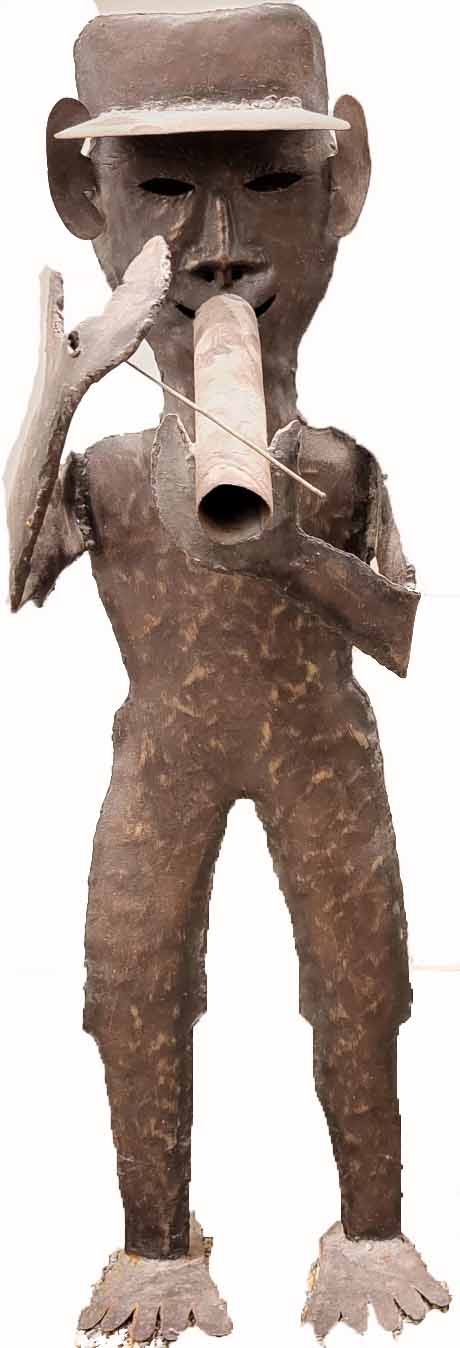 Rara musician Rara musicianMaker unknown Croix-des-Bouquets Metal Haiti Friends Collection |
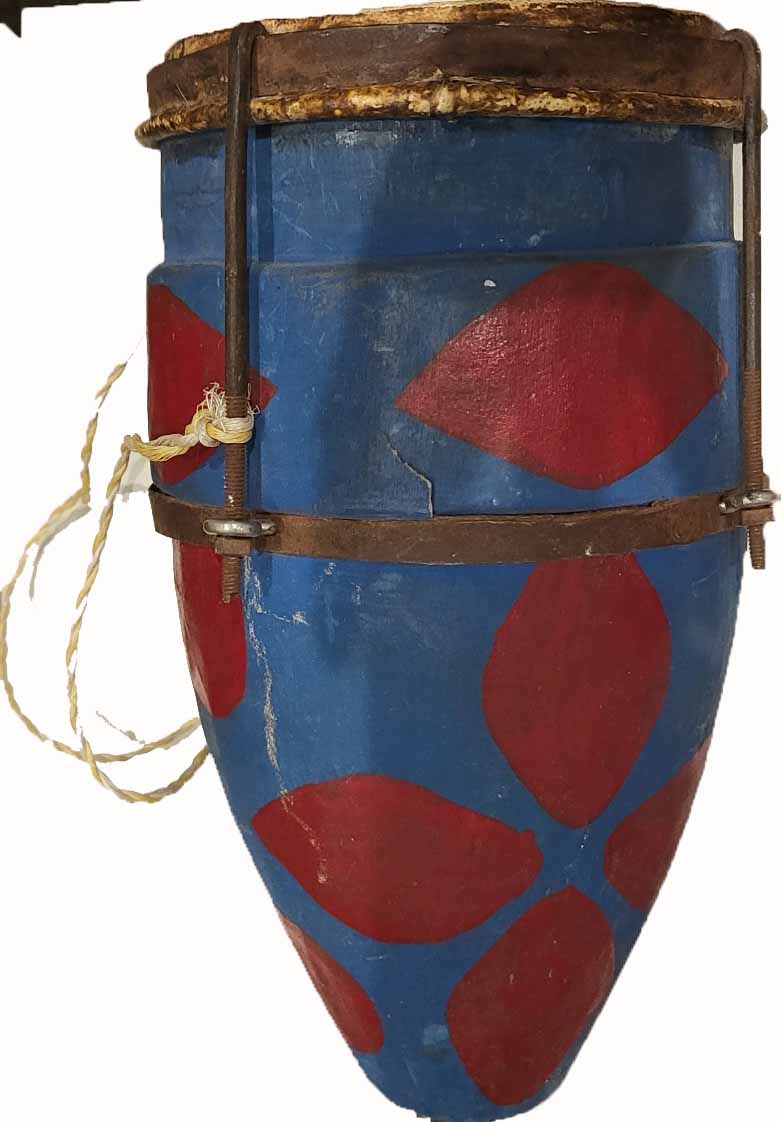 Drum DrumMaker unknown Wood, Leather Haiti Friends Collection |
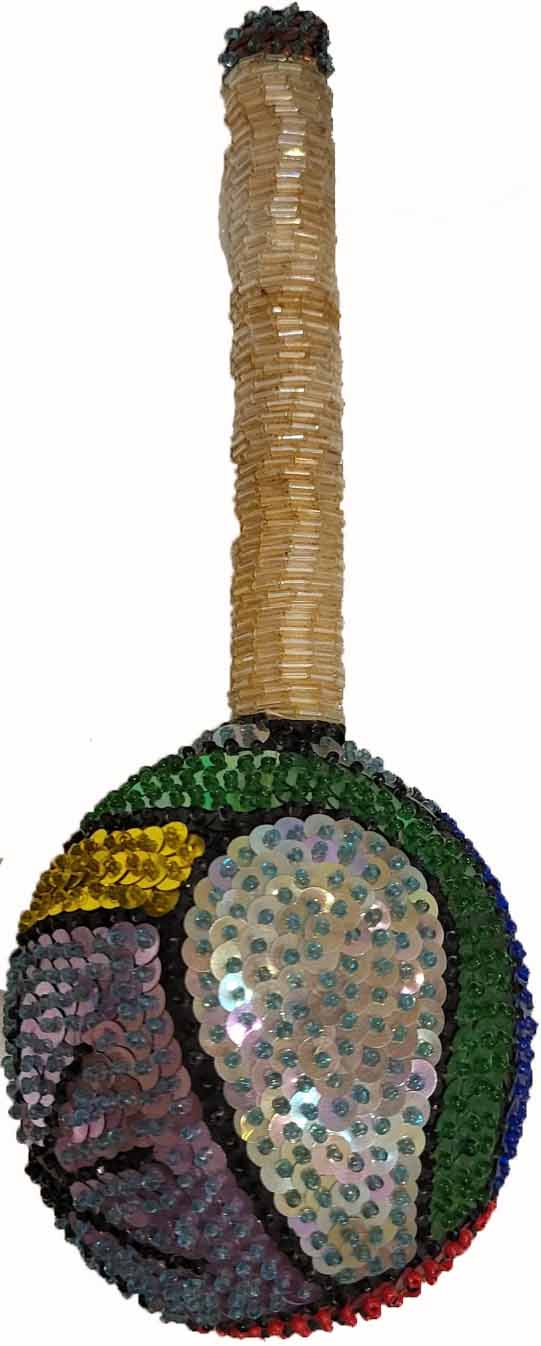 Shaker ShakerMaker unknown Wood, sequin Haiti Friends Collection |
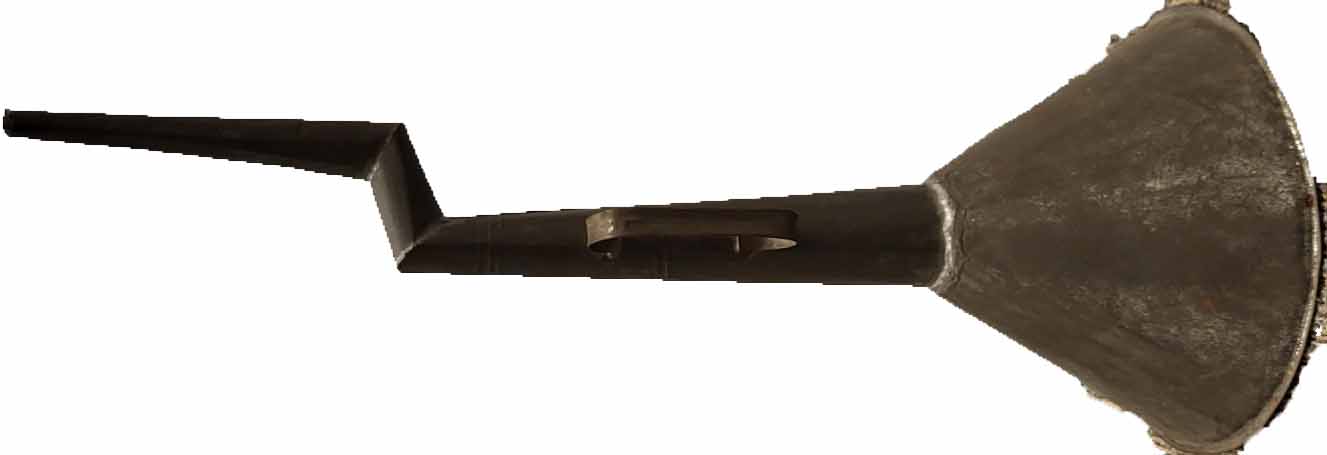 Horn HornMaker unknown Metal Haiti Friends Collection |
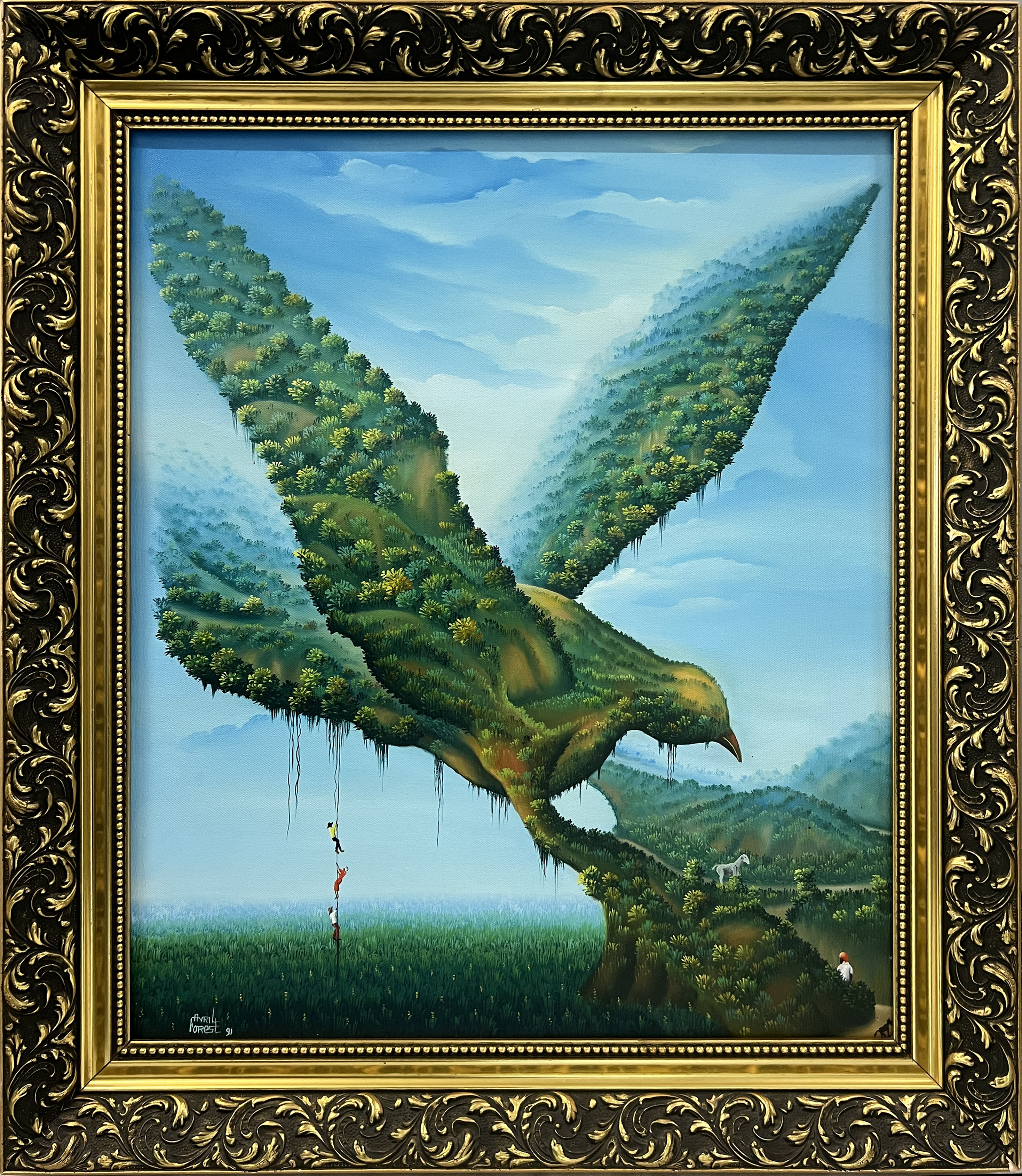 Nature's Messenger (Mesaje la nati) Nature's Messenger (Mesaje la nati)Avril Forest Haiti Friends Collection |
The body of this bird is depicted as a lush forest landscape, representing nature's restorative power. As the bird soars, it seems to carry this verdant ecosystem to far-flung, possibly troubled regions. People are portrayed attempting to climb aboard the avian figure, suggesting a desire to escape hardship for a better life. The imagery evokes themes of migration, renewal, and human yearning for peace and prosperity. The overall composition invites viewers to contemplate the possibility of a more harmonious existence and the role of the natural world in fostering such a reality.
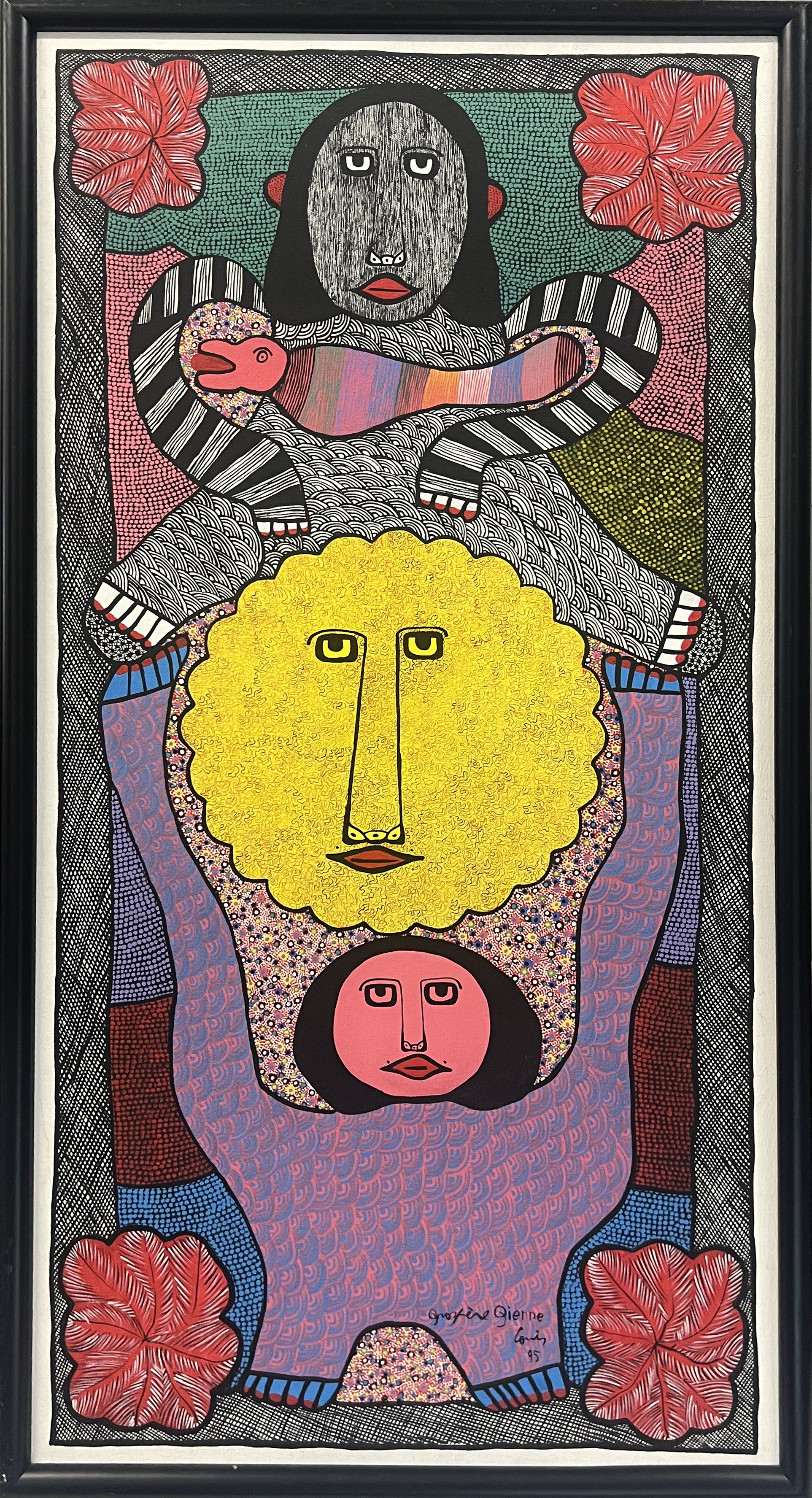 The Suns in Our Life (Prezans solèy la nan lavi nou) The Suns in Our Life (Prezans solèy la nan lavi nou)Louisiane Saint Fleurant (1924-2005) Haiti Friends Collection |
This painting explores humanity's relationship with the sun. The composition centers on a unique figure with two distinct faces surrounded by intricate patterns and designs. The figure's arms stretch upwards in a gesture of reverence, cradling a large, dominating yellow circle in the upper portion of the canvas. This circle, representing the sun, emphasizes its paramount importance in our existence. The face looking upward symbolizes humanity's constant search for enlightenment and guidance from the sun, while the forward-facing visage represents our grounding in the tangible world. This duality captures the essence of human existence, a balance between the celestial and the terrestrial.
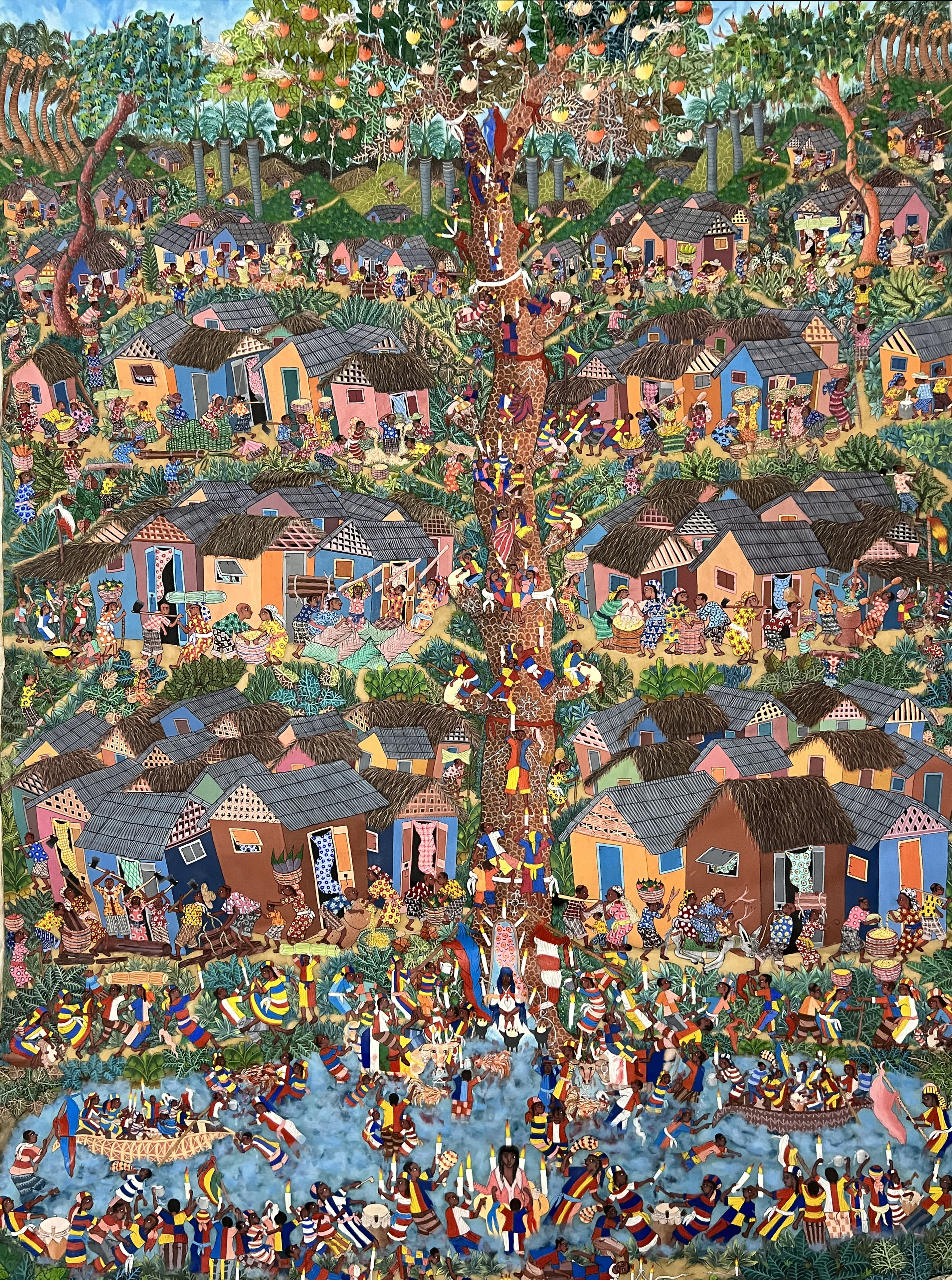 Gran Bwa Celebration (Seremoni Gran Bwa) Gran Bwa Celebration (Seremoni Gran Bwa) Serge Francois Haiti Friends Collection |
The ceremony depicted here honors Gran Bwa, a revered lwa (spirit) in Haitian Vodou. Gran Bwa, the guardian of forests and master of herbal medicine, is celebrated for his healing powers and role as nature's protector. The artist employs a powerful visual metaphor: the central pathway to a sacred pool, where pilgrims gather, is depicted as a tree trunk. Branching from this trunk are roads leading to various villages, symbolizing Gran Bwa's far-reaching influence and importance in the lives of the people.
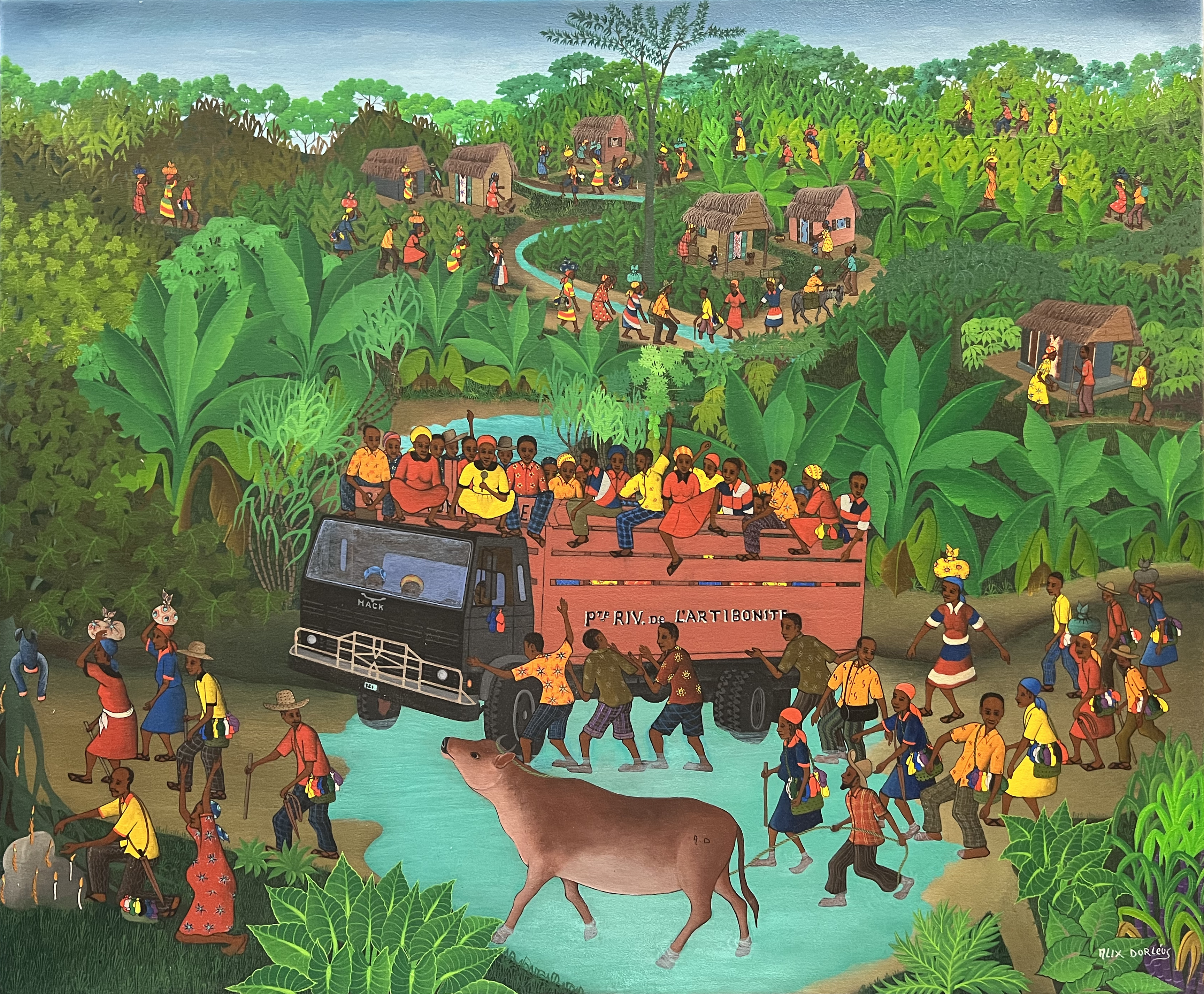 Departure for Saut d’Eau (Depa pou saut do) Departure for Saut d’Eau (Depa pou saut do)Alix Dorleus Haiti Friends Collection |
This work captures the essence of the sacred pilgrimage to Saut d’Eau, a site of deep spiritual resonance for Vodou practitioners. This hallowed place, nestled in the heart of Haiti, is where the physical and spiritual realms converge, offering a space for purification, renewal, and connection with the divine.
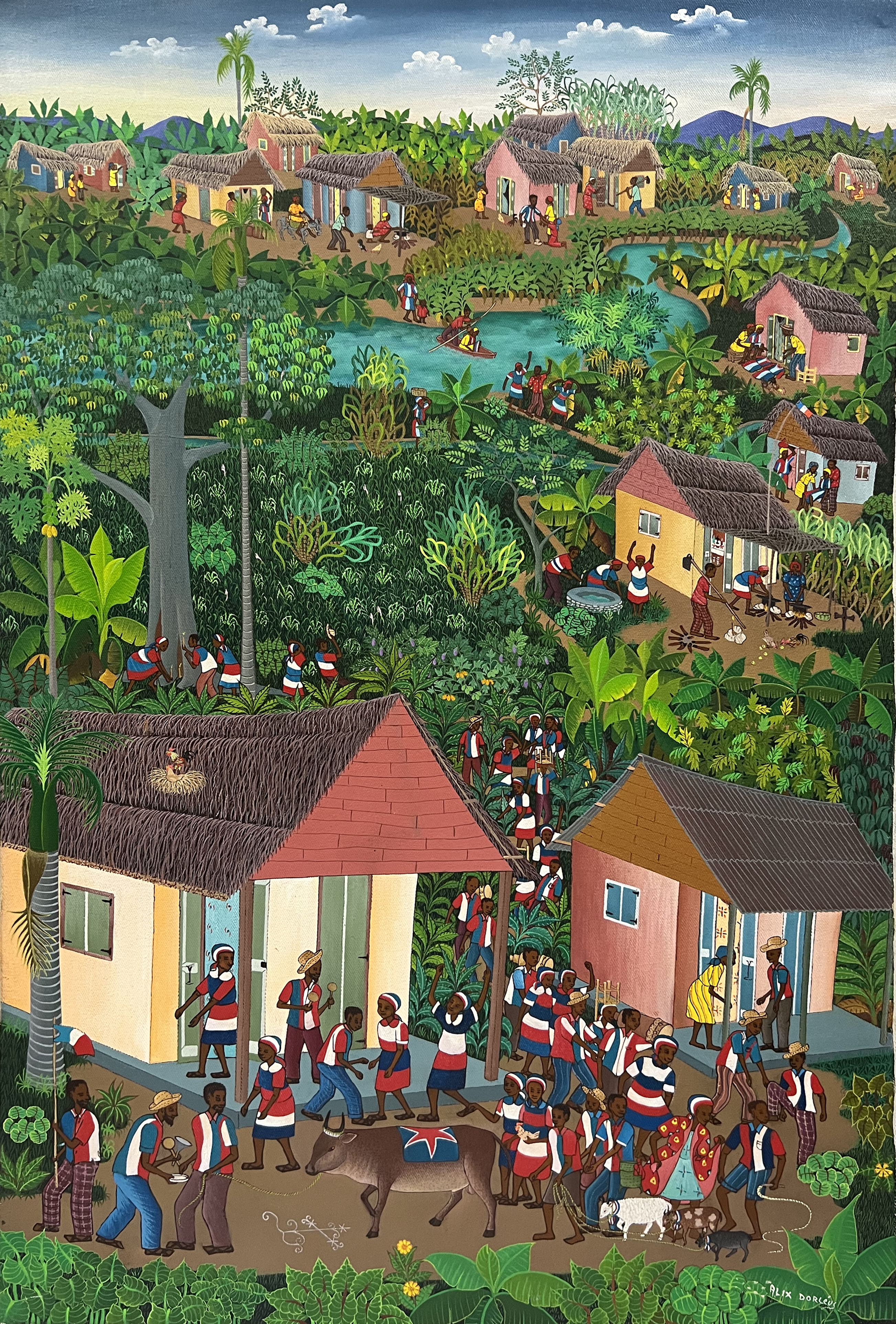 The Tour (La Tounen) The Tour (La Tounen)Alix Dorleus Haiti Friends Collection |
Prior to a Vodou ceremony, practitioners traverse the neighborhood, informing the entire village of the impending celebration for the lwa (spirits). This announcement serves as an invitation and a call to communal participation. Animals are sacrificed and prepared as part of the ceremony, their meat destined for both spiritual and physical nourishment. Farmers who have enjoyed bountiful harvests also contribute a portion of their produce.
This enduring tradition not only honors the spiritual realm but also fosters a sense of unity and shared prosperity in the community.
 Vodou Ceremony Vodou CeremonyLouis Gumcy Haiti Friends Collection |
The yearly Vodou ceremony is held at the house of the Hougan, the Vodou priest. The red, white, and blue flag on the floor symbolizes the presence of three significant lwa (spirits): Erzulie, whose white color represents love, beauty, and luxury; Ogou, whose red color signifies his warrior spirit, strength, and protection; and Danto, whose blue color reflects her fierce and protective nature as well as her connections to motherhood and justice.
 Brav Gede Brav GedeEdens Rousier Haiti Friends Collection |
This ceremony honors Brav Gede, a powerful lwa (spirit) in Haitian Vodou tradition. Known as the vigilant guardian of the graveyard, Brav Gede's sacred duty is to maintain the delicate balance between the world of the living and the domain of the dead. As the cosmic sentinel, he ensures that departed souls remain at peace in their eternal resting place, while simultaneously preventing the living from trespassing into the realm of the deceased.
 Vodou Ceremony in a Lakou (Seremoni Vodou nan yon Lakou) Vodou Ceremony in a Lakou (Seremoni Vodou nan yon Lakou) Joseph Augustin Haiti Friends Collection |
This glimpse into the spiritual world of Haitian Vodou captures a sacred ceremony taking place in a lakou—a traditional Haitian communal living space. At the heart of the scene is a white container holding a vibrant green liquid, symbolizing a potent herbal concoction prepared during the ritual with the aid of the lwa (spirits). The visible religious figures are the veves of Ougou Feray, the powerful lwa of war and fire; Ezili Danto, the fierce protector of women and children; and Agwe, the lwa of the sea.Through its detailed imagery, the painting offers a respectful portrayal of Vodou practice, highlighting its complexity, its deep roots in nature, and its integral role in Haitian culture and spirituality.
 Baron des Baron (Baron of Barons) Baron des Baron (Baron of Barons)Stivenson Magloire (1963-1994) Haiti Friends Collection |
Baron Samedi is the formidable lwa (spirit) known as the "Baron des Baron" (Baron of Barons) in Haitian Vodou. As the supreme figure among the Gede family of spirits, Baron Samedi commands a pivotal role in the spiritual landscape. The painting captures the essence of this powerful entity, who stands at the crossroads of life and death. As the master of the afterlife, Baron Samedi is portrayed with his characteristic blend of solemnity and mischief, reflecting his complex nature.
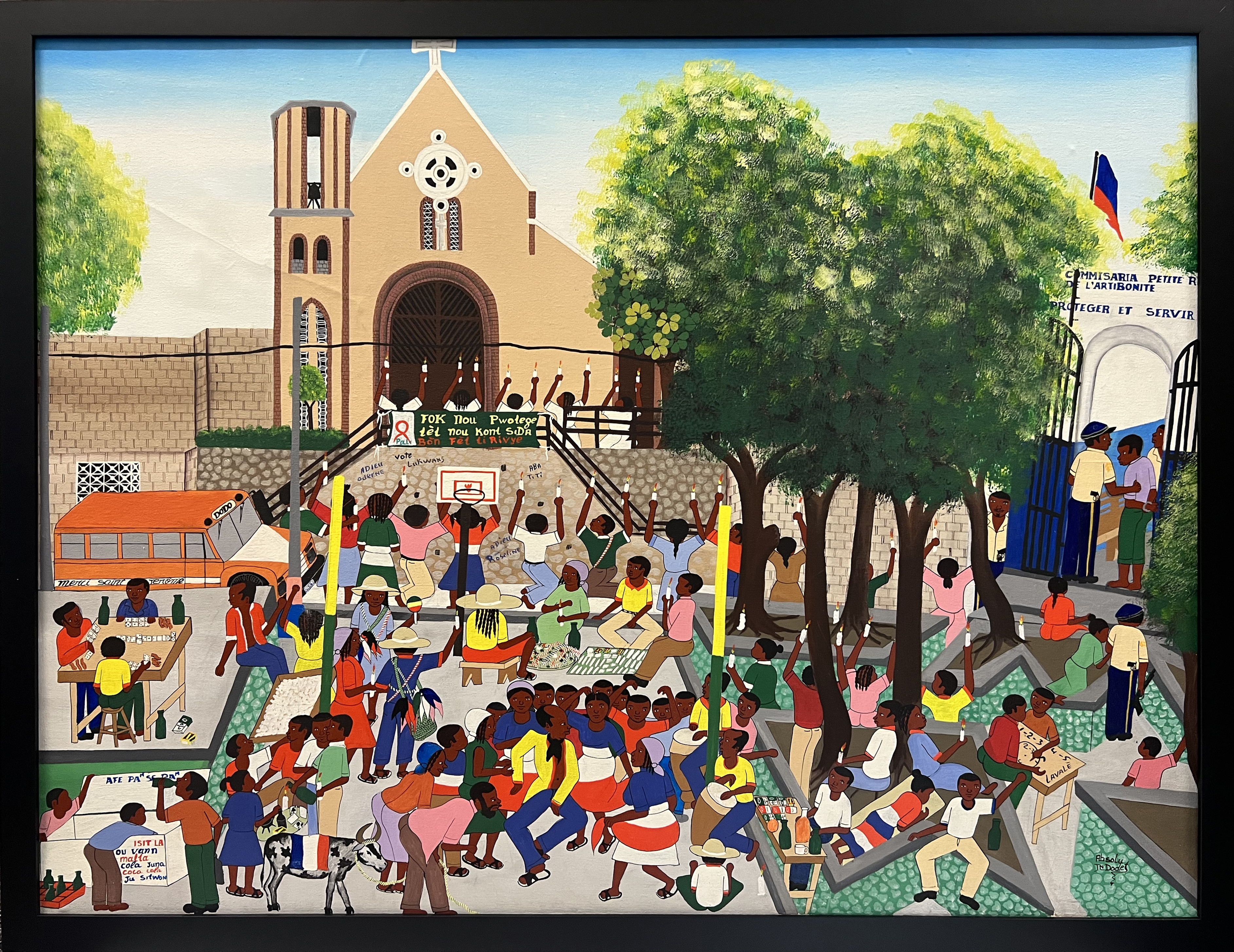 Saint Jerome Patronal Celebration (Fèt pawonal Saint Jerome) Saint Jerome Patronal Celebration (Fèt pawonal Saint Jerome)Absolu Jean Dodet Haiti Friends Collection |
This vibrant traditional celebration of Saint Jerome's Day in Petite Rivière de l'Artibonite showcases the unique cultural fusion that characterizes Haitian spiritual practices. In Haitian Vodou, Saint Jerome is a representation of Ogou Balendyo, a powerful lwa (spirit) in the Vodou pantheon. This celebration vividly demonstrates the syncretic nature of Haitian spirituality, where Catholic saints and Vodou lwa coexist and often intertwine.


